forest schools - 28/3/25
Our forest school session began with an exciting knot practice challenge. Using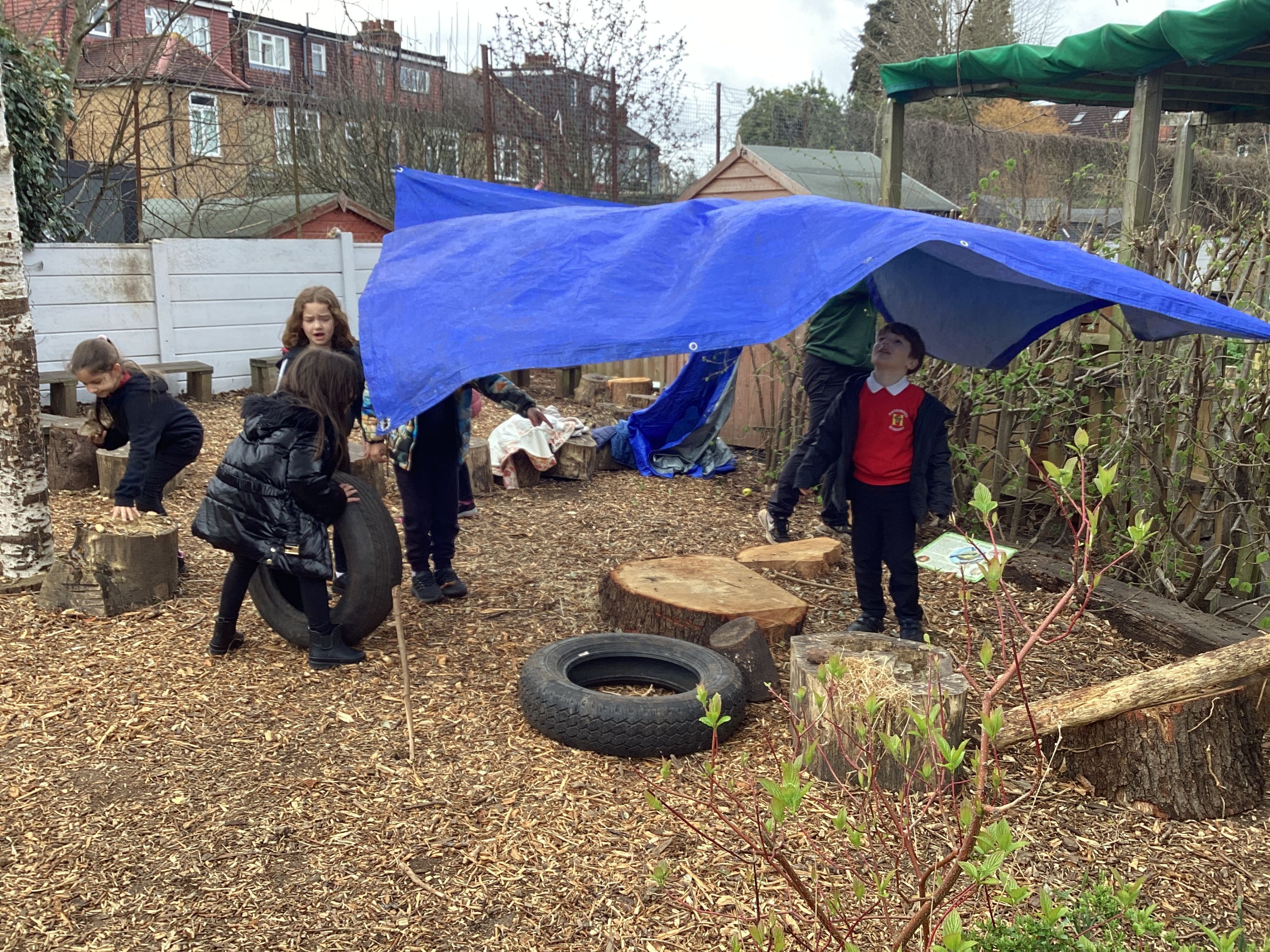 cord, the children practised the art of winding and binding to master the overhand knot. They wrapped the cord around a stick and secured their knots, showing lots of resilience and teamwork as they helped each another along the way. Once everyone felt confident with their knot-tying skills, we turned our attention to building a den, which would protect baby animals in the wild and also protect us from the day’s drizzle. The children discussed the essential features of a good den, such as choosing a location near branches
cord, the children practised the art of winding and binding to master the overhand knot. They wrapped the cord around a stick and secured their knots, showing lots of resilience and teamwork as they helped each another along the way. Once everyone felt confident with their knot-tying skills, we turned our attention to building a den, which would protect baby animals in the wild and also protect us from the day’s drizzle. The children discussed the essential features of a good den, such as choosing a location near branches 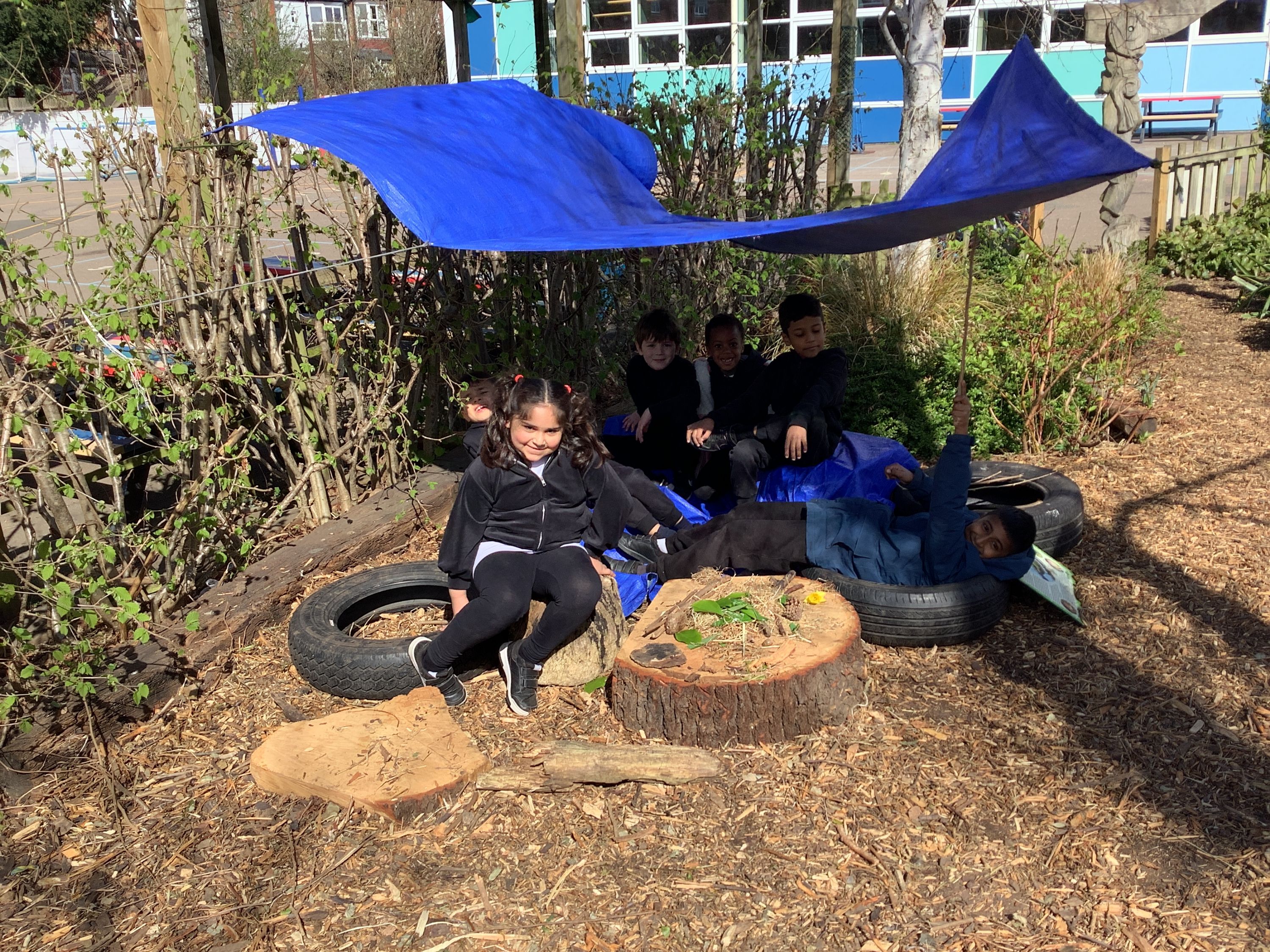 and tree trunks to tie the cord and considered the den’s roof. Would it have a sloping shape, or perhaps resemble a tent? They discussed the height of their den, assessing which features would best suit their design. With the guidance of Julia, our forest school teacher, the children observed how to loop the cord through the tarp before securing it with an overhand knot and tying it to a sturdy tree branch. They then ventured off to create their own cosy dens, using a sheet of tarp and natural resources found in
and tree trunks to tie the cord and considered the den’s roof. Would it have a sloping shape, or perhaps resemble a tent? They discussed the height of their den, assessing which features would best suit their design. With the guidance of Julia, our forest school teacher, the children observed how to loop the cord through the tarp before securing it with an overhand knot and tying it to a sturdy tree branch. They then ventured off to create their own cosy dens, using a sheet of tarp and natural resources found in 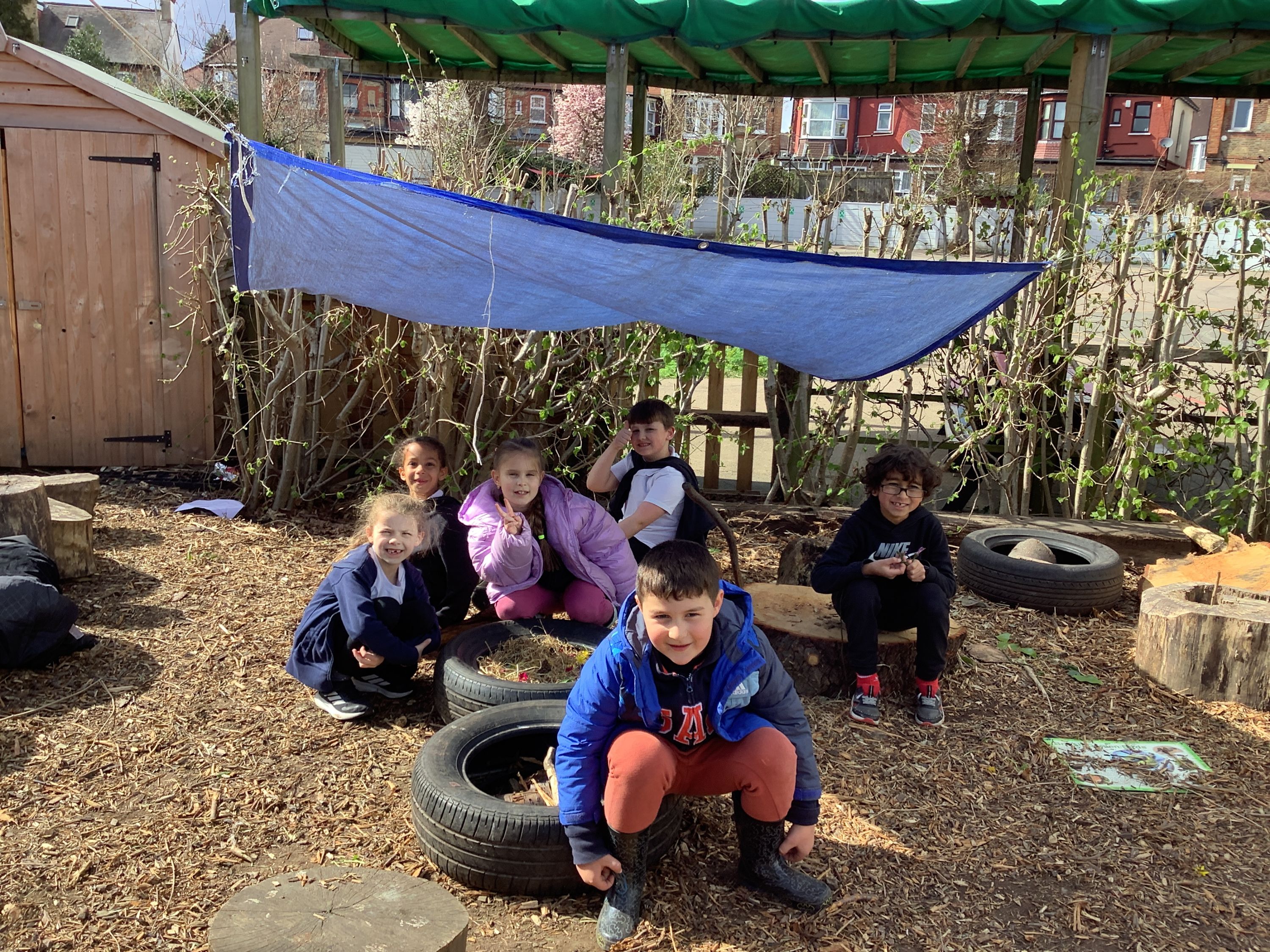 the garden. Logs and tyres became comfortable seats and a makeshift fire pit, while the children showed their creativity in constructing their dens, including secret tunnels! As the session drew to a close, we gathered around the base camp for a warm cup of berry tea and shared positive experiences and points for improvement regarding their den-building adventures.
the garden. Logs and tyres became comfortable seats and a makeshift fire pit, while the children showed their creativity in constructing their dens, including secret tunnels! As the session drew to a close, we gathered around the base camp for a warm cup of berry tea and shared positive experiences and points for improvement regarding their den-building adventures.
forest schools - 21/3/25
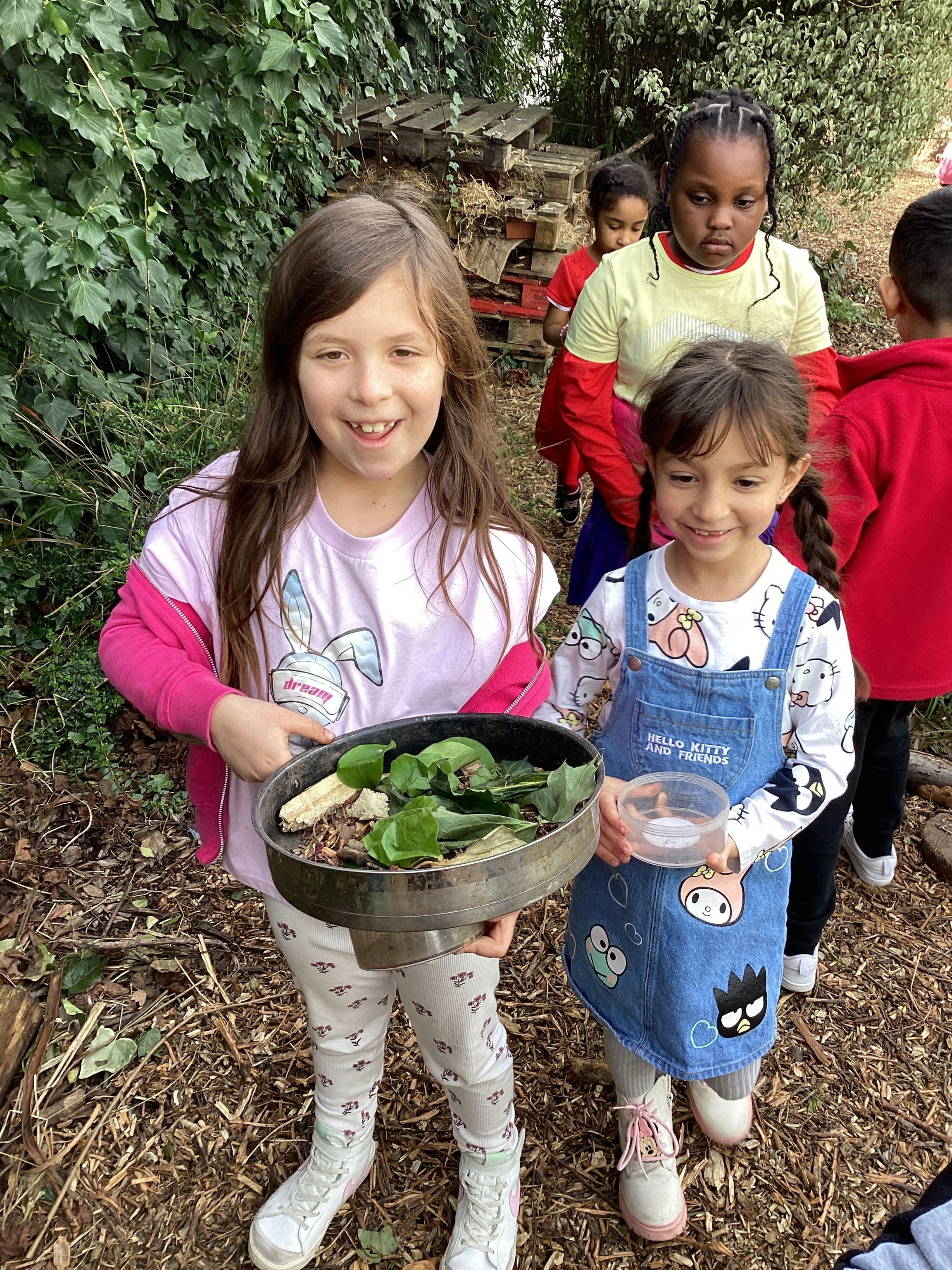 As part of our Science learning and personal development, the children explored the wonders of spring and the arrival of the spring equinox during this Forest School session, learning that daytime and night time are now equal. They discovered a special sign of spring through the birdcalls heard around them and were fascinated by a real bird’s nest found hidden in the garden's ivy. Together, we discussed how birds are laying eggs, raising hatchlings, and how those hatchlings grow into fledglings ready to fly. The children listened carefully to recordings of bird songs from species often found in the Hazelwood garden, such as robins with their red breasts, sparrows, blackbirds
As part of our Science learning and personal development, the children explored the wonders of spring and the arrival of the spring equinox during this Forest School session, learning that daytime and night time are now equal. They discovered a special sign of spring through the birdcalls heard around them and were fascinated by a real bird’s nest found hidden in the garden's ivy. Together, we discussed how birds are laying eggs, raising hatchlings, and how those hatchlings grow into fledglings ready to fly. The children listened carefully to recordings of bird songs from species often found in the Hazelwood garden, such as robins with their red breasts, sparrows, blackbirds 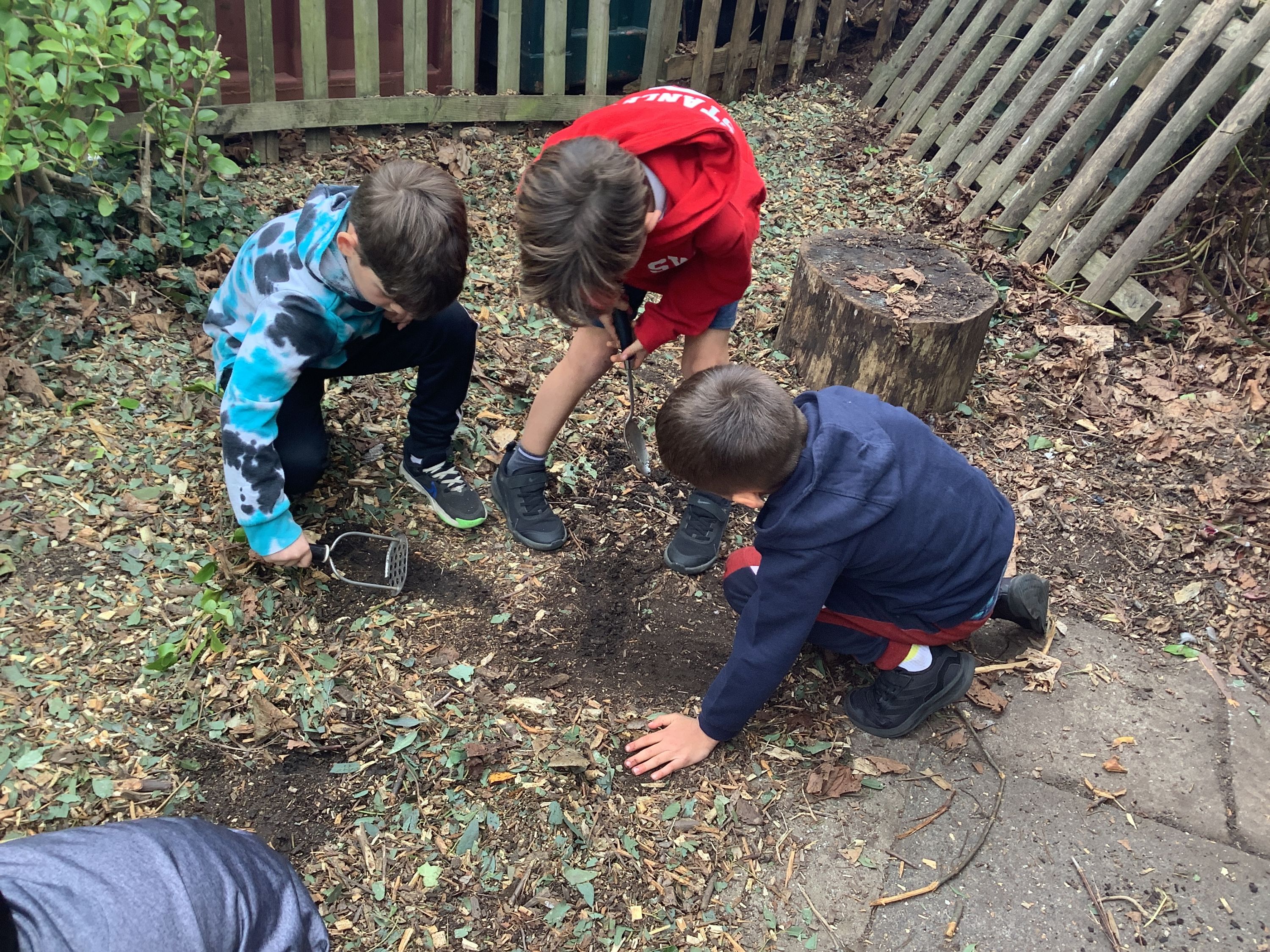 with their black feathers and yellow beaks, blue tits with bright blue and yellow plumage, nocturnal owls, woodpeckers, and starlings. Using toy bird models, they observed these details up close, then had fun mimicking bird calls with their own voices. The session continued with learning about the materials birds use to build cosy nests — twigs, wool, cotton, leaf skeletons, soft leaves, and straw — and how they weave these together. The children were then
with their black feathers and yellow beaks, blue tits with bright blue and yellow plumage, nocturnal owls, woodpeckers, and starlings. Using toy bird models, they observed these details up close, then had fun mimicking bird calls with their own voices. The session continued with learning about the materials birds use to build cosy nests — twigs, wool, cotton, leaf skeletons, soft leaves, and straw — and how they weave these together. The children were then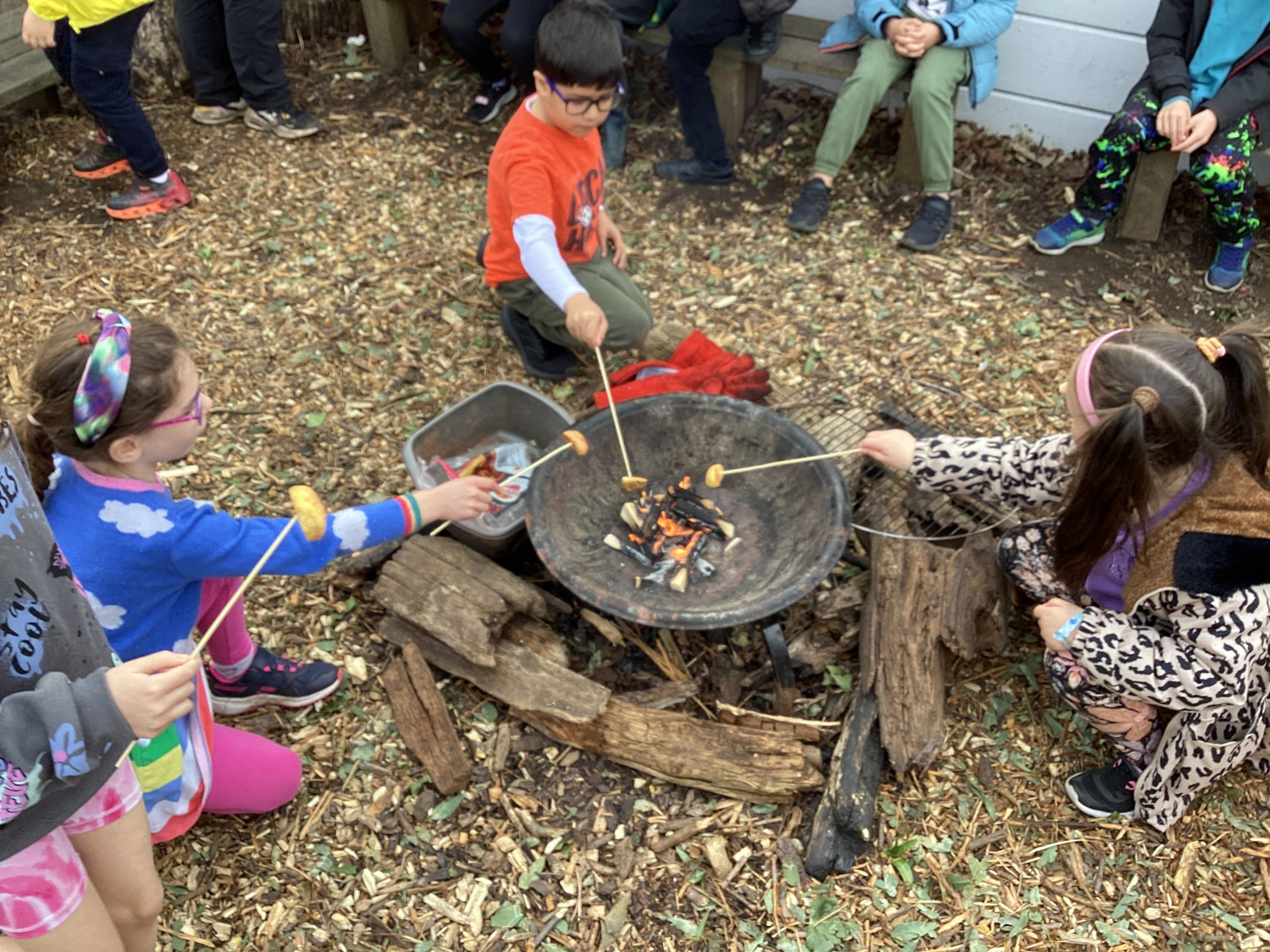 challenged to build their own small nests using natural materials from the garden, practising weaving just like birds. As they worked, they found insects such as woodlice and imagined how birds might gather these to feed their young. To finish the day, everyone gathered around the campfire, toasting apple slices dipped in cinnamon on skewers, enjoying the delicious smell and taste while listening to the story ‘The Birds,’ a tale celebrating the personalities of different birds.
challenged to build their own small nests using natural materials from the garden, practising weaving just like birds. As they worked, they found insects such as woodlice and imagined how birds might gather these to feed their young. To finish the day, everyone gathered around the campfire, toasting apple slices dipped in cinnamon on skewers, enjoying the delicious smell and taste while listening to the story ‘The Birds,’ a tale celebrating the personalities of different birds.
Trip to tate modern
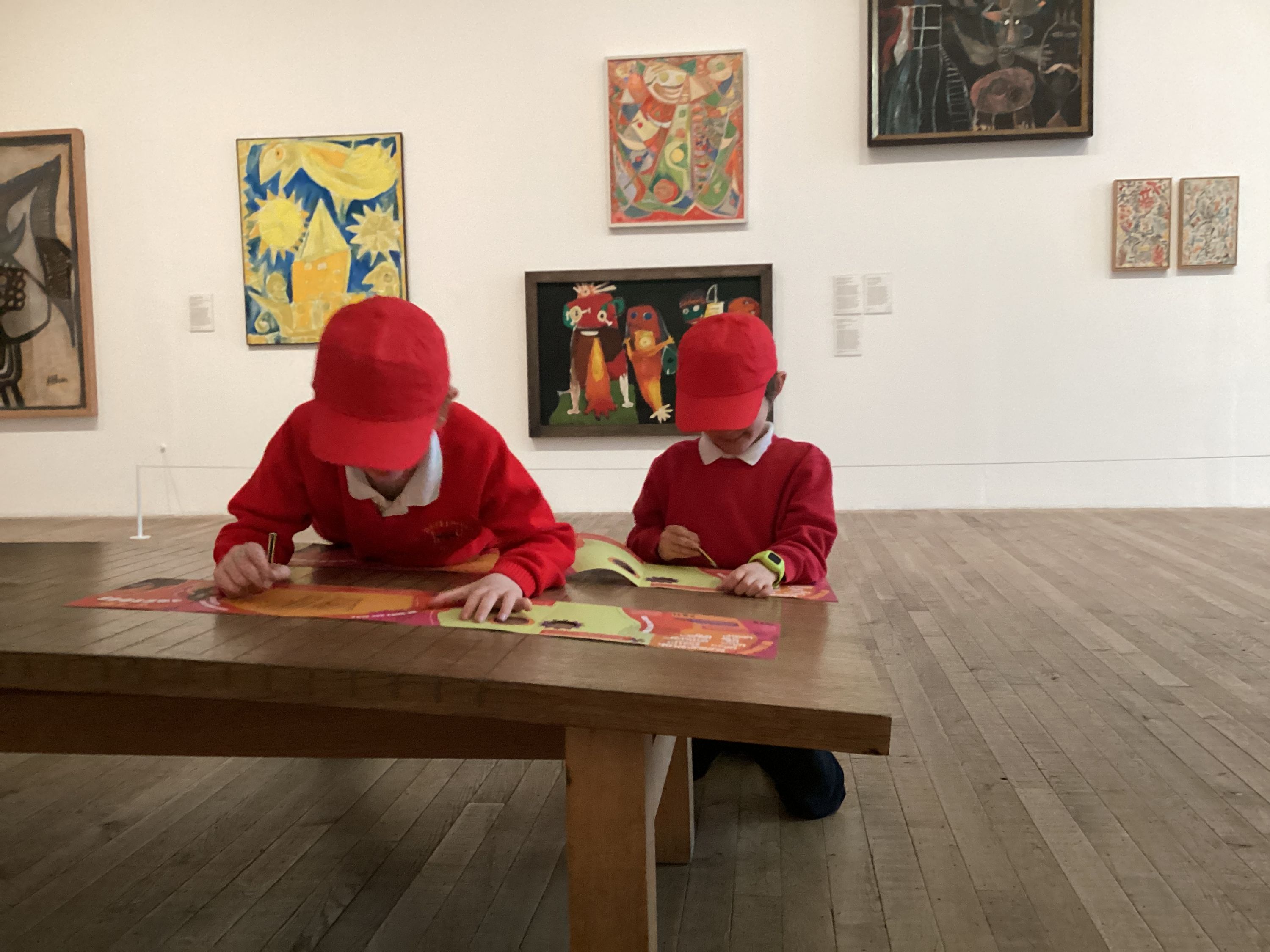 We had an exciting school trip to Tate Modern as part of our personal development and our Art learning on expressive painting. We explored the gallery exhibits, engaging in thoughtful discussions about the different paintings and artworks we saw. Drawing from our lessons, we reflected on how the
We had an exciting school trip to Tate Modern as part of our personal development and our Art learning on expressive painting. We explored the gallery exhibits, engaging in thoughtful discussions about the different paintings and artworks we saw. Drawing from our lessons, we reflected on how the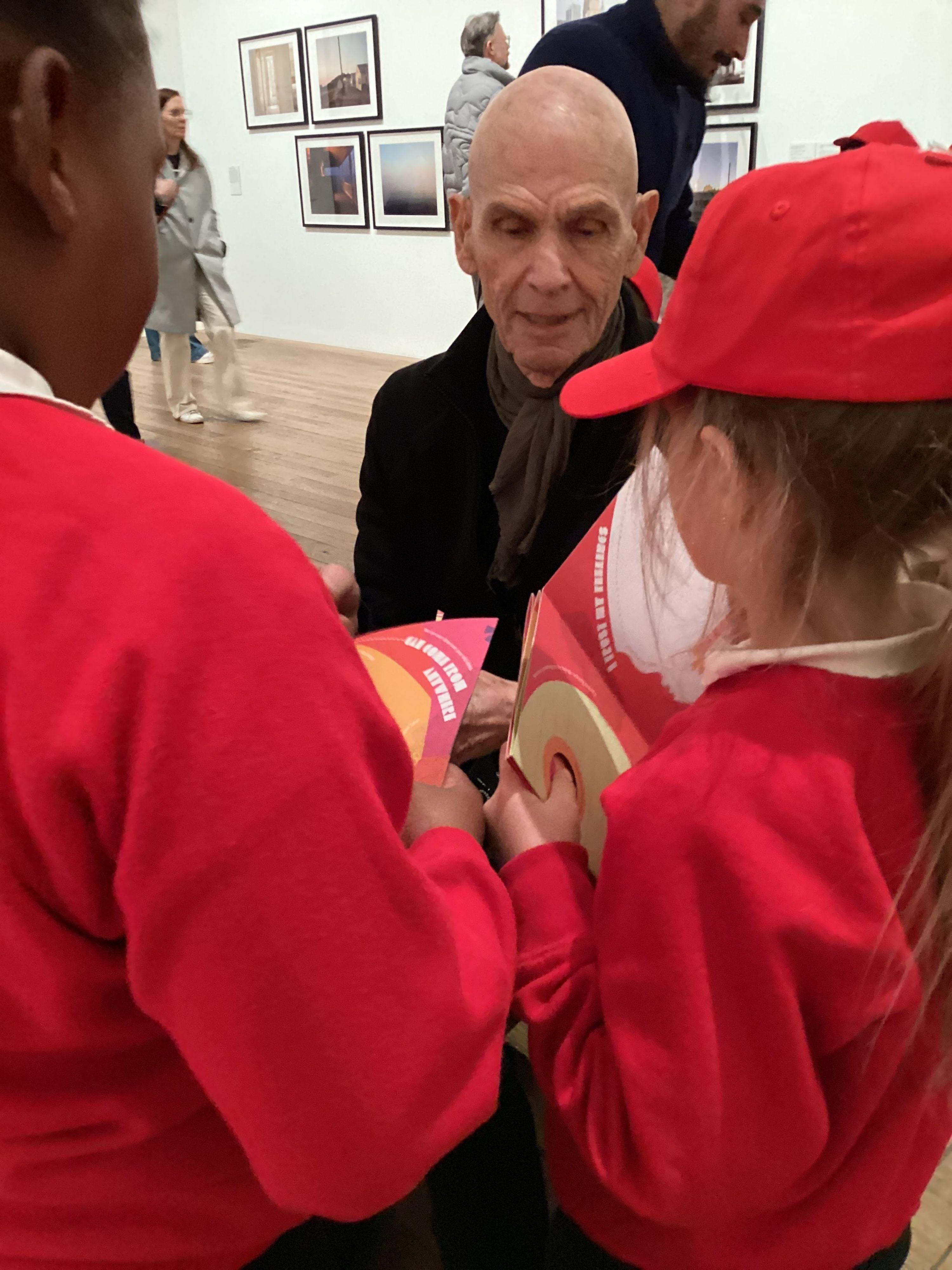 pieces made us feel and analysed the techniques used by the artists, such as thickly applied paint, paint mixed directly on the canvas, contrasting colours, and the use of shapes and lines in abstract art. We recorded our observations in booklets through writing and visual notes, just as we had practised in our Art lessons. A highlight of the trip was an unexpected encounter with photographer Joel Meyerowitz, whose work is exhibited in the museum. We were thrilled to meet him and eagerly listened as he spoke about his artistic journey and inspirations.
pieces made us feel and analysed the techniques used by the artists, such as thickly applied paint, paint mixed directly on the canvas, contrasting colours, and the use of shapes and lines in abstract art. We recorded our observations in booklets through writing and visual notes, just as we had practised in our Art lessons. A highlight of the trip was an unexpected encounter with photographer Joel Meyerowitz, whose work is exhibited in the museum. We were thrilled to meet him and eagerly listened as he spoke about his artistic journey and inspirations.
forest schools - 7/3/25
 As part of our Science learning and personal development, this forest school session the children celebrated World Book Day through the story of ‘The Green Man'. As they gathered around the campfire with warm apple juice, they listened to the tale of a vain young prince who lost his fine clothes and horse in the forest, only to be shaped by nature into the Green Man. Alone in the woods, he learned to forage for food, build shelters, care for animals, and protect lost
As part of our Science learning and personal development, this forest school session the children celebrated World Book Day through the story of ‘The Green Man'. As they gathered around the campfire with warm apple juice, they listened to the tale of a vain young prince who lost his fine clothes and horse in the forest, only to be shaped by nature into the Green Man. Alone in the woods, he learned to forage for food, build shelters, care for animals, and protect lost  children, eventually embracing his new life as the guardian of the forest. Inspired by this story, the children engaged in hands-on, nature-based activities. They worked together to build
children, eventually embracing his new life as the guardian of the forest. Inspired by this story, the children engaged in hands-on, nature-based activities. They worked together to build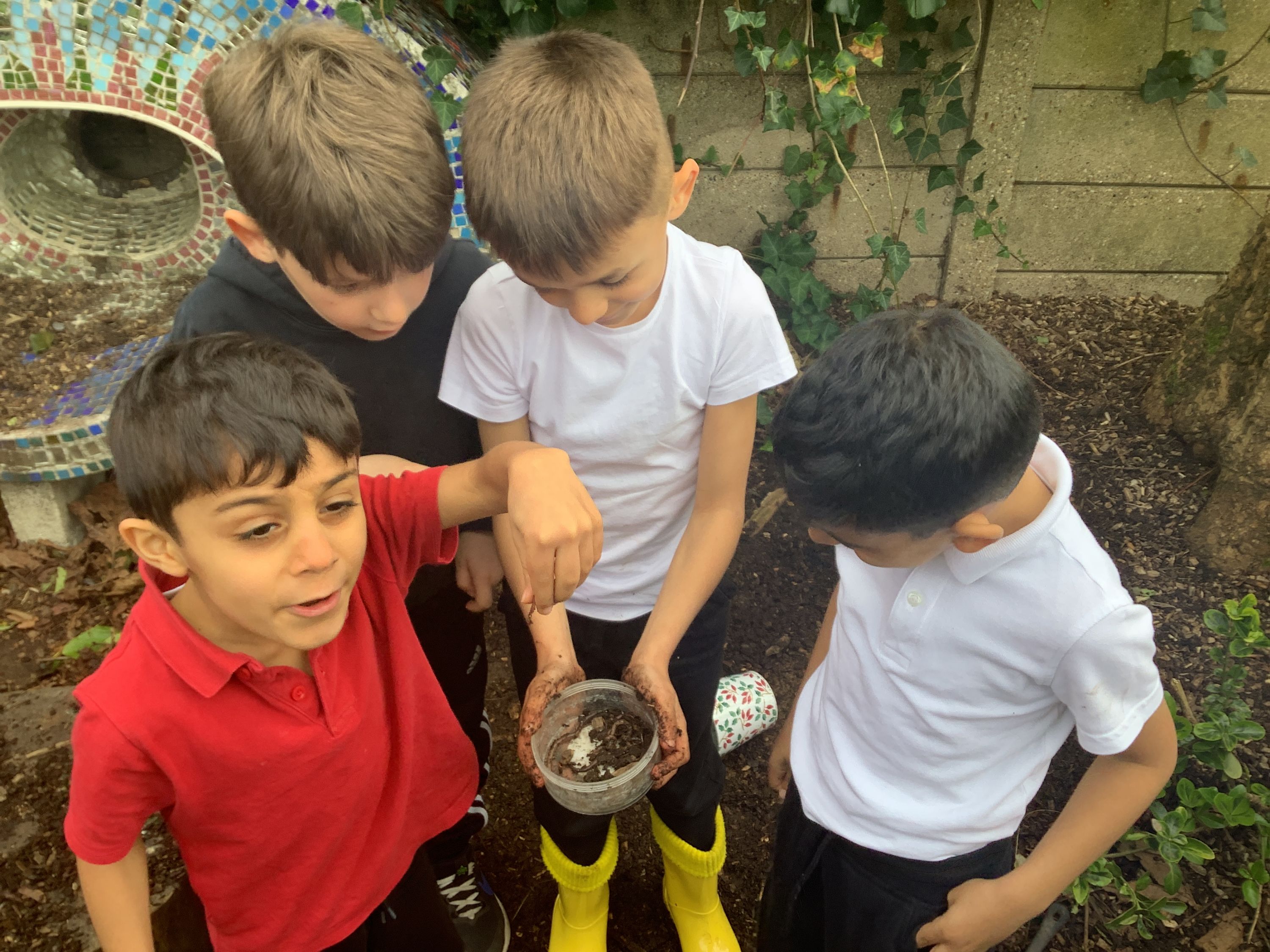 miniature woodland dens for the Green Man, carefully weaving sticks, leaves, and logs into shelters. With clay, they crafted small pots and planters, imagining that the Green Man might use them to grow plants and nurture the forest. They also made pine cone bird feeders, carefully spreading them with fat and oats to feed the birds in our garden. Showing our school value of creativity, they crafted
miniature woodland dens for the Green Man, carefully weaving sticks, leaves, and logs into shelters. With clay, they crafted small pots and planters, imagining that the Green Man might use them to grow plants and nurture the forest. They also made pine cone bird feeders, carefully spreading them with fat and oats to feed the birds in our garden. Showing our school value of creativity, they crafted Japanese – inspired bookmarks, hammering fresh flowers and leaves onto cotton strips to imprint their natural pigments. Throughout the session, the children also immersed themselves in imaginative play, taking on the roles of their favourite book characters in the mud kitchen, where they stirred up "forest feasts" and magical potions.
Japanese – inspired bookmarks, hammering fresh flowers and leaves onto cotton strips to imprint their natural pigments. Throughout the session, the children also immersed themselves in imaginative play, taking on the roles of their favourite book characters in the mud kitchen, where they stirred up "forest feasts" and magical potions.
forest schools - 28/2/25
As part of our Science learning and Personal Development, we started our first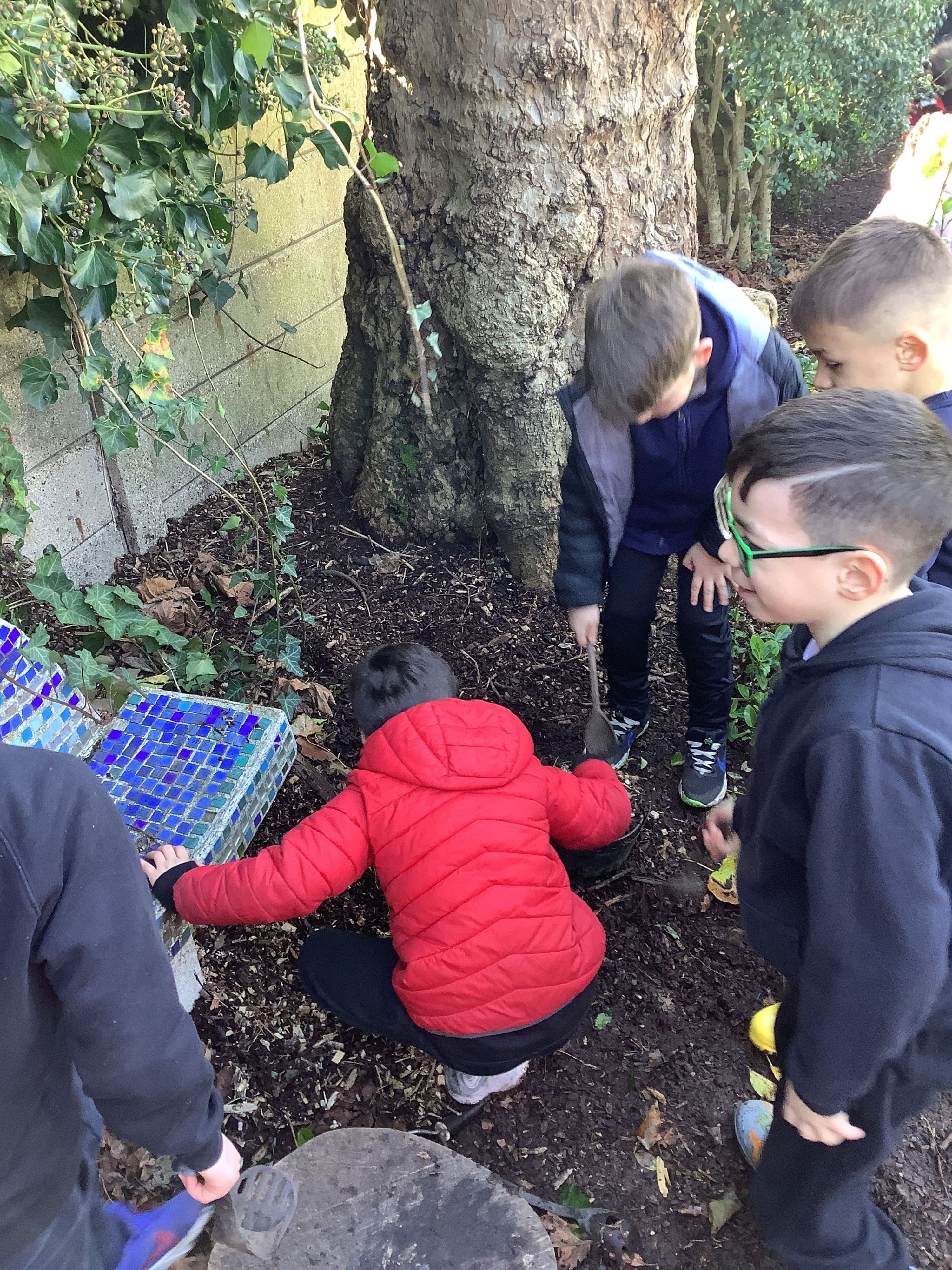 Forest School session with an exciting hunt for brightly coloured ribbons, which helped us bring to life the story of St. Bridget and the arrival of Spring. As we followed along, we acted out key moments—shivering in the lingering cold, planting seeds with hope, and mirroring Bridget’s acts of kindness. Inspired by the story, we discussed how Winter fades away as the snow melts, tiny shoots emerge, and birdsong fills the air.
Forest School session with an exciting hunt for brightly coloured ribbons, which helped us bring to life the story of St. Bridget and the arrival of Spring. As we followed along, we acted out key moments—shivering in the lingering cold, planting seeds with hope, and mirroring Bridget’s acts of kindness. Inspired by the story, we discussed how Winter fades away as the snow melts, tiny shoots emerge, and birdsong fills the air. 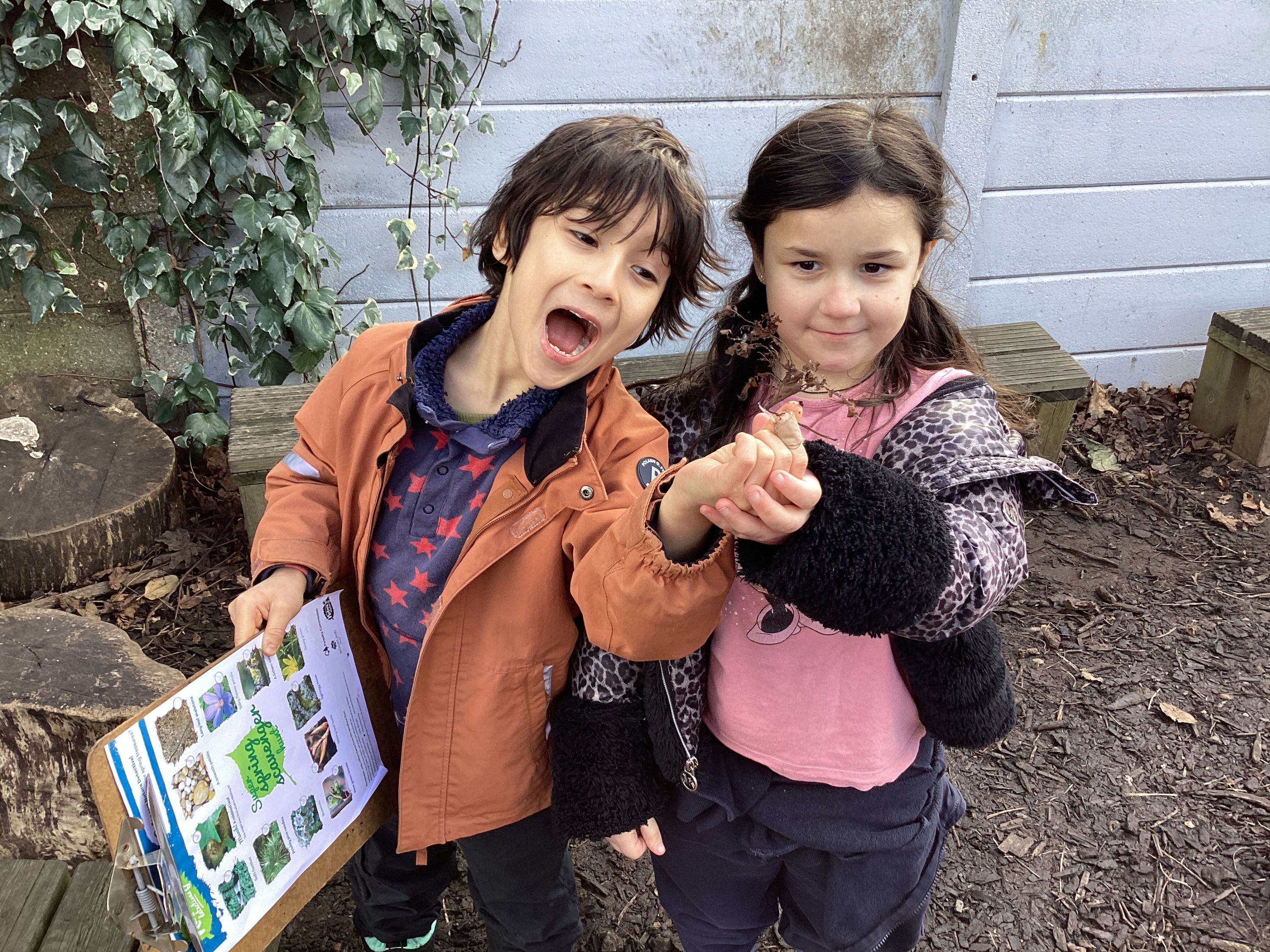 Embracing the change of seasons, we became nature detectives, searching our garden for the first signs of Spring. We looked for delicate blossoms, sticky leaf buds, soft feathers, sprigs of moss on twigs, and leaves nibbled by hungry creatures. We showed lots of excitement for the changing season, and look forward to spotting more signs of Spring in the
Embracing the change of seasons, we became nature detectives, searching our garden for the first signs of Spring. We looked for delicate blossoms, sticky leaf buds, soft feathers, sprigs of moss on twigs, and leaves nibbled by hungry creatures. We showed lots of excitement for the changing season, and look forward to spotting more signs of Spring in the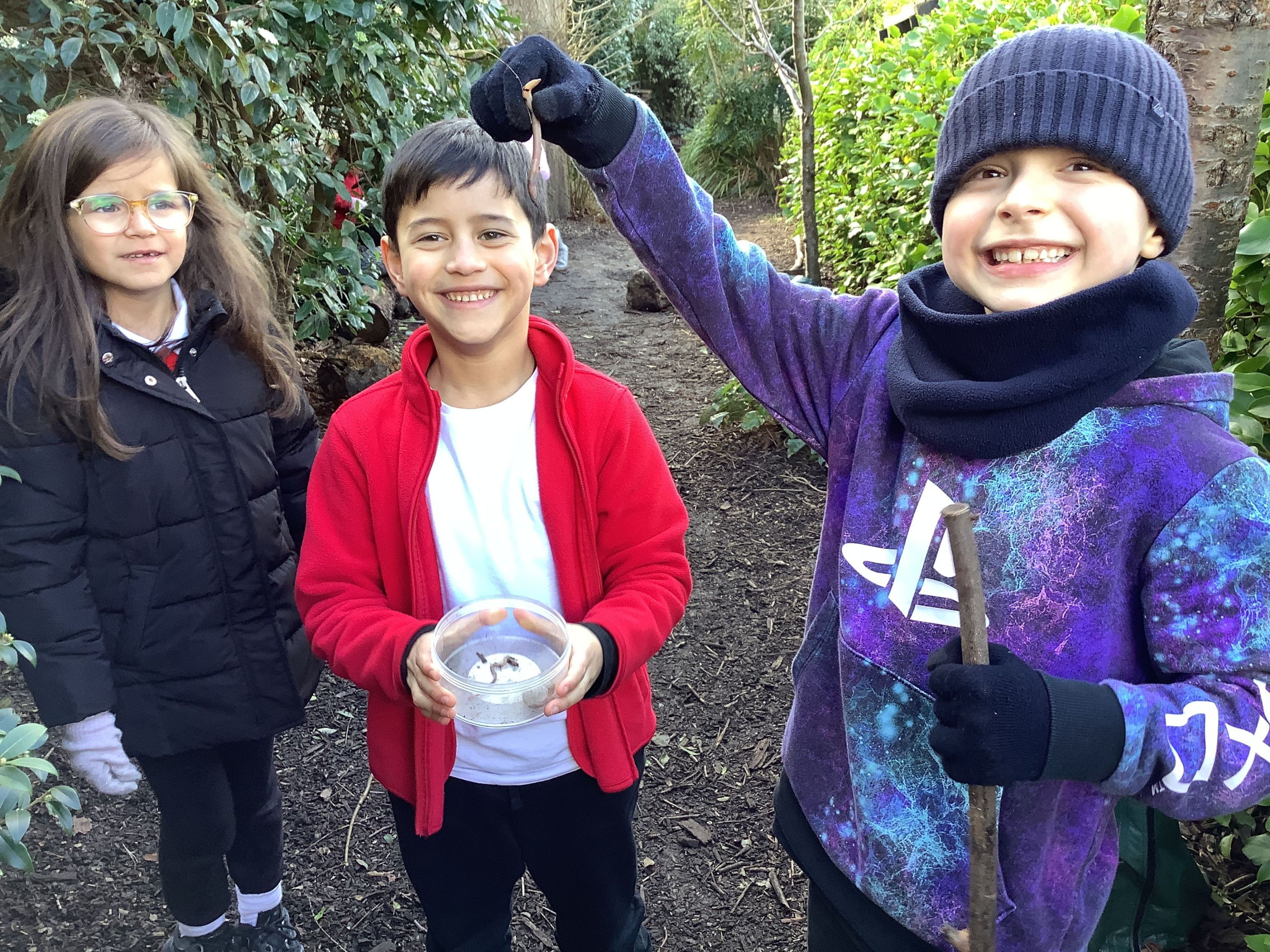 coming weeks. To end our session, we gathered around the campfire, learning how to stay safe and understanding the fire triangle. We watched as the flame grew, and took in the smoky scent of the burning wood. As a final treat, we brewed berry-flavoured tea, smelling its rich aroma before enjoying it together by the fire.
coming weeks. To end our session, we gathered around the campfire, learning how to stay safe and understanding the fire triangle. We watched as the flame grew, and took in the smoky scent of the burning wood. As a final treat, we brewed berry-flavoured tea, smelling its rich aroma before enjoying it together by the fire.
Trip to tate modern
As part of our Art unit 'Surface and Colour' and personal development, the children will visit Tate Modern on Tuesday 11th March. The children will consolidate their learning on expressive painting and explore the work of expressionist and impressionist painters such as Van Gogh, Cezanne and Monet. They will also observe and discuss the techniques used and the impact on the viewer.
Please click the link below to give permission for your child to attend:
Google Form
You can find more information in the letter below.

Expressive painting workshop
 As part of our Art unit 'Surface and Colour' and personal development, the children participated in an expressive painting workshop with artist Laura McKendry. During this exciting and interactive workshop, they explored the world of expressionist painting, applying everything they had learnt in their Art lessons about how colours, marks, and textures can be used to express emotions. The session began with a short introduction, where the Laura shared her work and introduced famous expressionist painters. Through discussion, children explored the meaning of "expression" and how painting can capture feelings in unique and personal ways.
As part of our Art unit 'Surface and Colour' and personal development, the children participated in an expressive painting workshop with artist Laura McKendry. During this exciting and interactive workshop, they explored the world of expressionist painting, applying everything they had learnt in their Art lessons about how colours, marks, and textures can be used to express emotions. The session began with a short introduction, where the Laura shared her work and introduced famous expressionist painters. Through discussion, children explored the meaning of "expression" and how painting can capture feelings in unique and personal ways.
To encourage creativity, the children experimented with different mark-making tools instead of traditional brushes to create interesting textures and effects. In their groups, they discussed how different objects might be painted using a variety of marks and colours, sparking ideas for their own artwork.
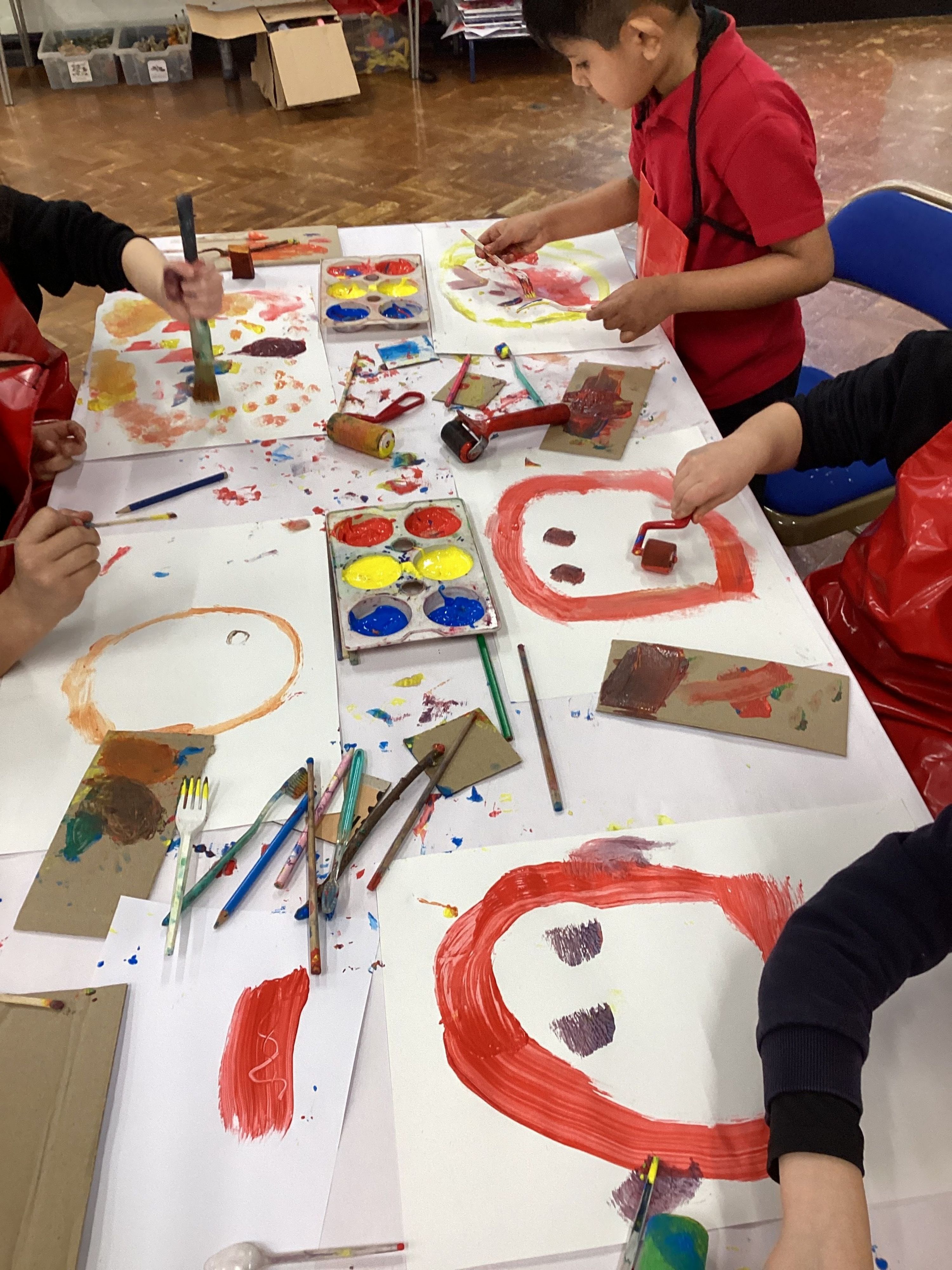 The workshop included several hands-on activities, starting with a fun warm-up game called "Pass the Painting." Each child made a single mark on a piece of paper before passing it around the table for others to add to, encouraging collaboration and imaginative thinking. They then moved on to "Painting a Feeling," where they used colours and marks to visually represent emotions like whispering, confusion, sadness, and calm. Children also experimented with scraping into the paint to create layered effects.
The workshop included several hands-on activities, starting with a fun warm-up game called "Pass the Painting." Each child made a single mark on a piece of paper before passing it around the table for others to add to, encouraging collaboration and imaginative thinking. They then moved on to "Painting a Feeling," where they used colours and marks to visually represent emotions like whispering, confusion, sadness, and calm. Children also experimented with scraping into the paint to create layered effects.
Finally, they created expressive self-portraits using only mark-making tools, focusing on how different colours and strokes could reflect their emotions that day. Throughout the session, they wer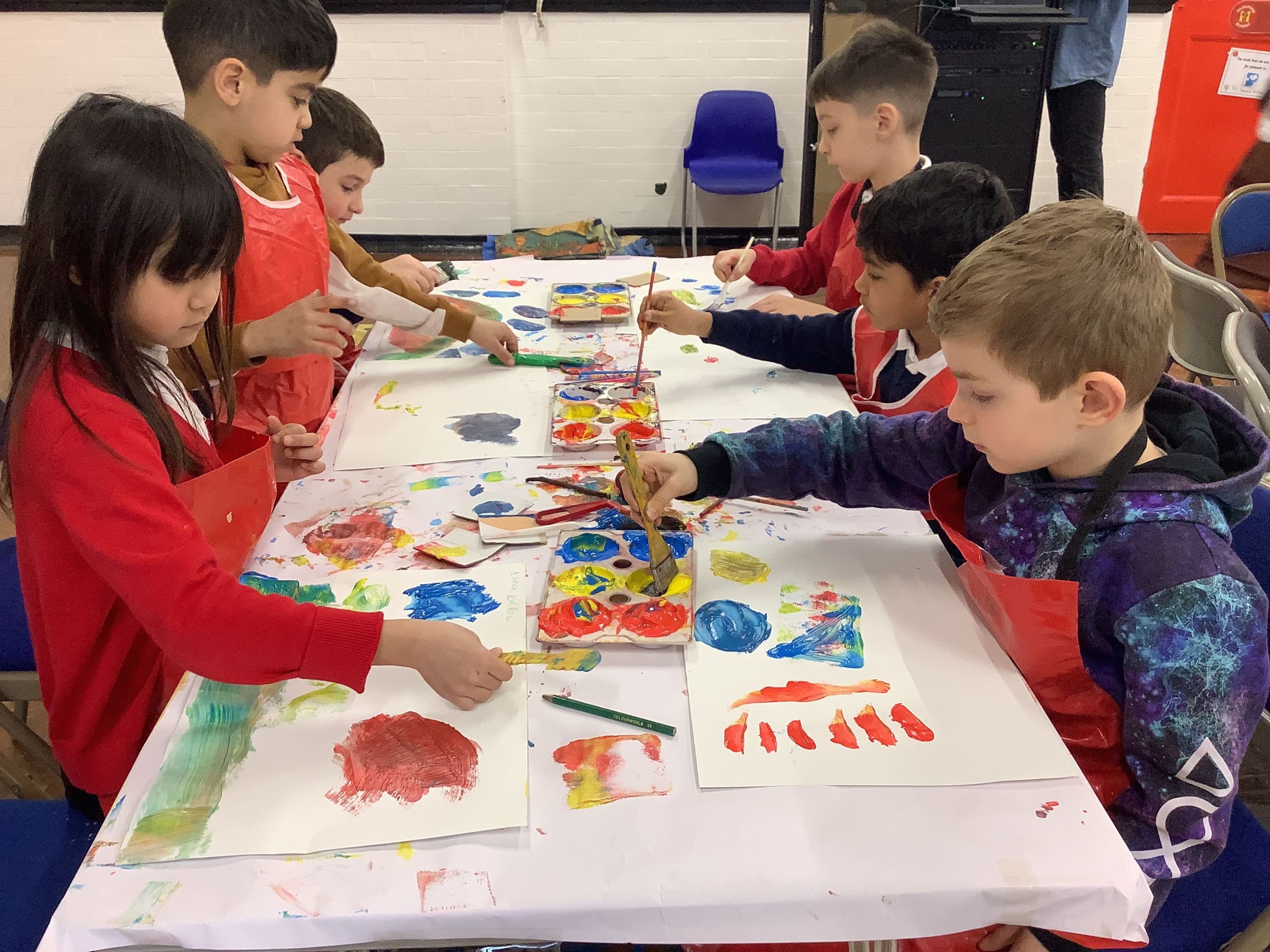 e reminded to be expressive and playful, to avoid overmixing colours to keep them vibrant, and most importantly, to enjoy the process without worrying about making their paintings look "realistic." A huge thank you to Laura for leading this inspiring workshop and encouraging the children to explore their creativity in new and exciting ways. It was a fantastic experience, and we truly appreciate the time and passion she shared with us!
e reminded to be expressive and playful, to avoid overmixing colours to keep them vibrant, and most importantly, to enjoy the process without worrying about making their paintings look "realistic." A huge thank you to Laura for leading this inspiring workshop and encouraging the children to explore their creativity in new and exciting ways. It was a fantastic experience, and we truly appreciate the time and passion she shared with us!
Maths parent workshop
 The Year 2 Maths Parent Workshop was a fantastic experience for the children! Alongside their parents and carers, they participated in a hands-on lesson focused on position, direction, and measurement.
The Year 2 Maths Parent Workshop was a fantastic experience for the children! Alongside their parents and carers, they participated in a hands-on lesson focused on position, direction, and measurement.
The session began with a warm-up activity, where children used the four compass points to locate different shapes on a grid. This led to the main challenge: mapping out Chippy the robot’s journey. Given a description of his movements—measured in metres and guided by compass points—the children worked to map out his path on squared paper, calculate the total distance he travelled, and determine his route back to the base station.
the robot’s journey. Given a description of his movements—measured in metres and guided by compass points—the children worked to map out his path on squared paper, calculate the total distance he travelled, and determine his route back to the base station.
It was wonderful to see everyone deeply engaged in discussions, sharing strategies on how best to track Chippy’s journey and calculate distances. The workshop highlighted key school values such as teamwork, resilience, and ambition, as children and adults exchanged ideas and reasoned through different approaches. Thank you to all the parents/carers who joined us for the workshop – your 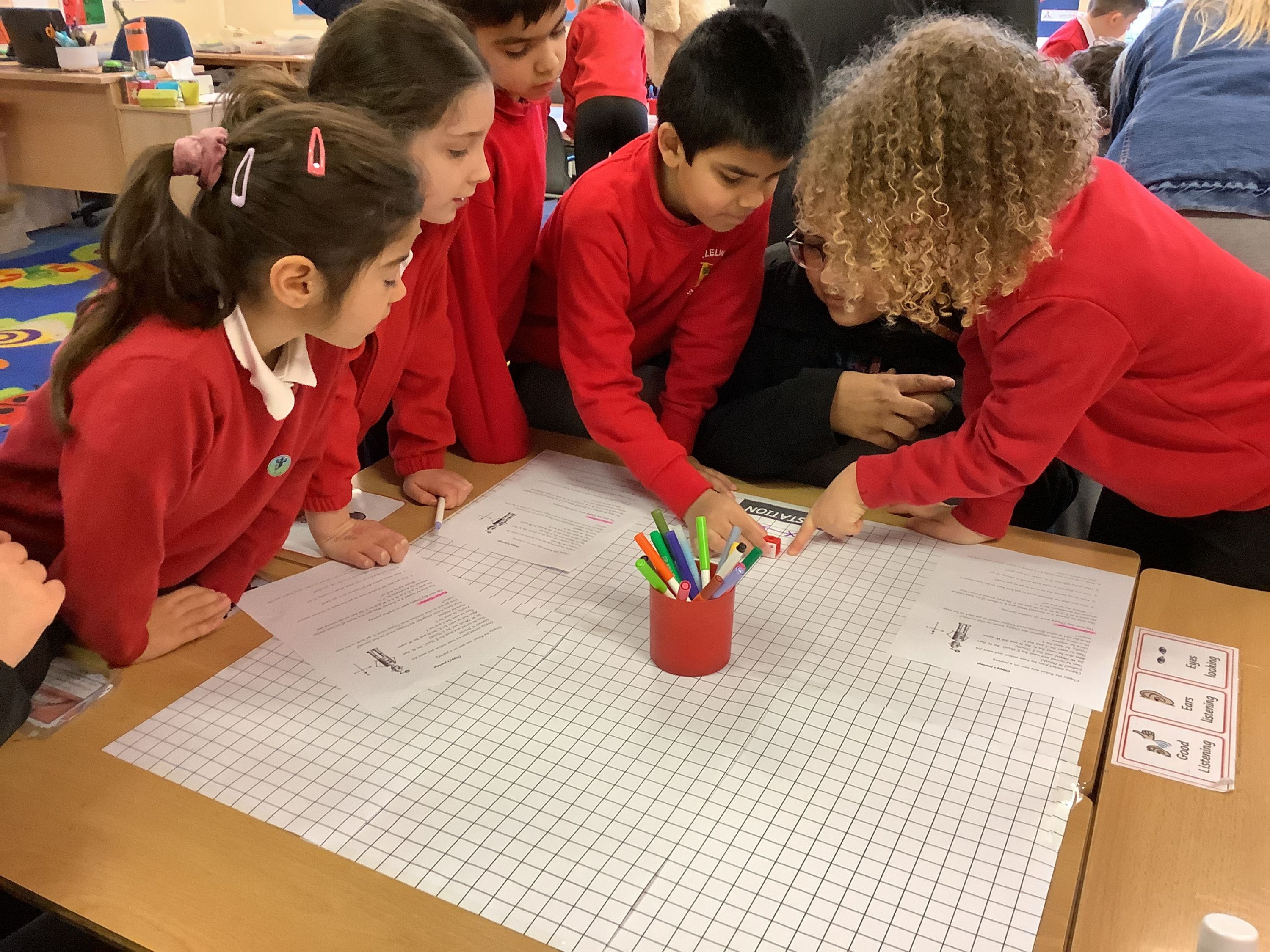 continued support is greatly appreciated!
continued support is greatly appreciated!
If you were unable to attend the session or would like to refer back to the information we shared, please visit the Maths page on our website to see the slides for Year 2. There, you will also find a copy of our whole school calculation policy.
Expressive painting workshop
On Wednesday 12th February, the Year 2 children will participate in an expressive painting workshop, as part of our Art unit 'Surface and Colour'. The workshop will be led by Laura McKendry, a local artist and parent at Hazelwood. The children will explore a variety of expressive painting techniques to create multiple paintings, which they will collate into a collage. We are very grateful to Laura for leading this workshop with the children.
Please see the letter below for more information:
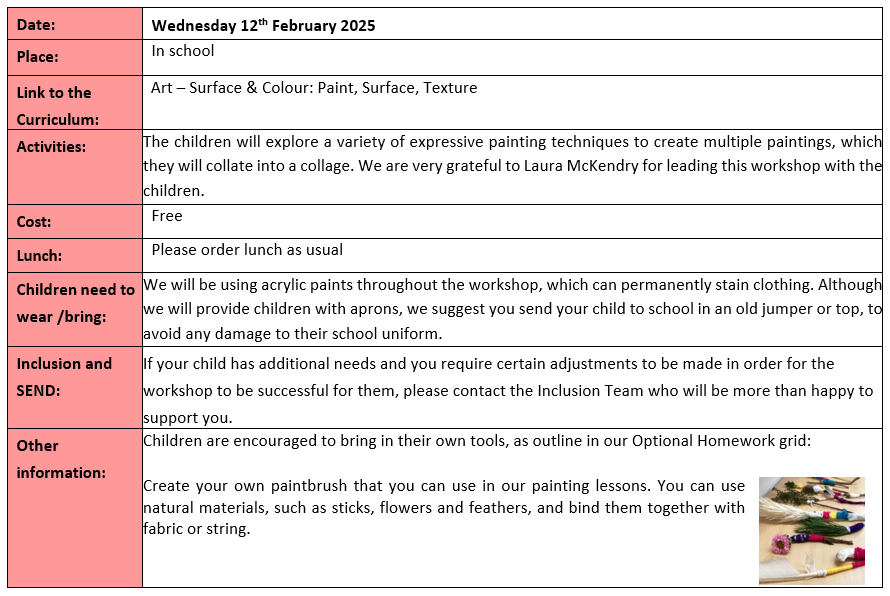
Our first weeks back and Key dates for Spring 1
 The Year 2 children immersed themselves in the book How to Find Gold by Viviane Schwarz in their English lessons, creating story maps and story mountains to map out the narrative. They then began innovating the story, inventing their own sea creatures for the characters to encounter and using ambitious adjectives and similes to describe them in preparation for writing their own versions of the story. In Maths, the children focused on money, practising skills such as making specific amounts, comparing values, calculating with money, and working out how to make one
The Year 2 children immersed themselves in the book How to Find Gold by Viviane Schwarz in their English lessons, creating story maps and story mountains to map out the narrative. They then began innovating the story, inventing their own sea creatures for the characters to encounter and using ambitious adjectives and similes to describe them in preparation for writing their own versions of the story. In Maths, the children focused on money, practising skills such as making specific amounts, comparing values, calculating with money, and working out how to make one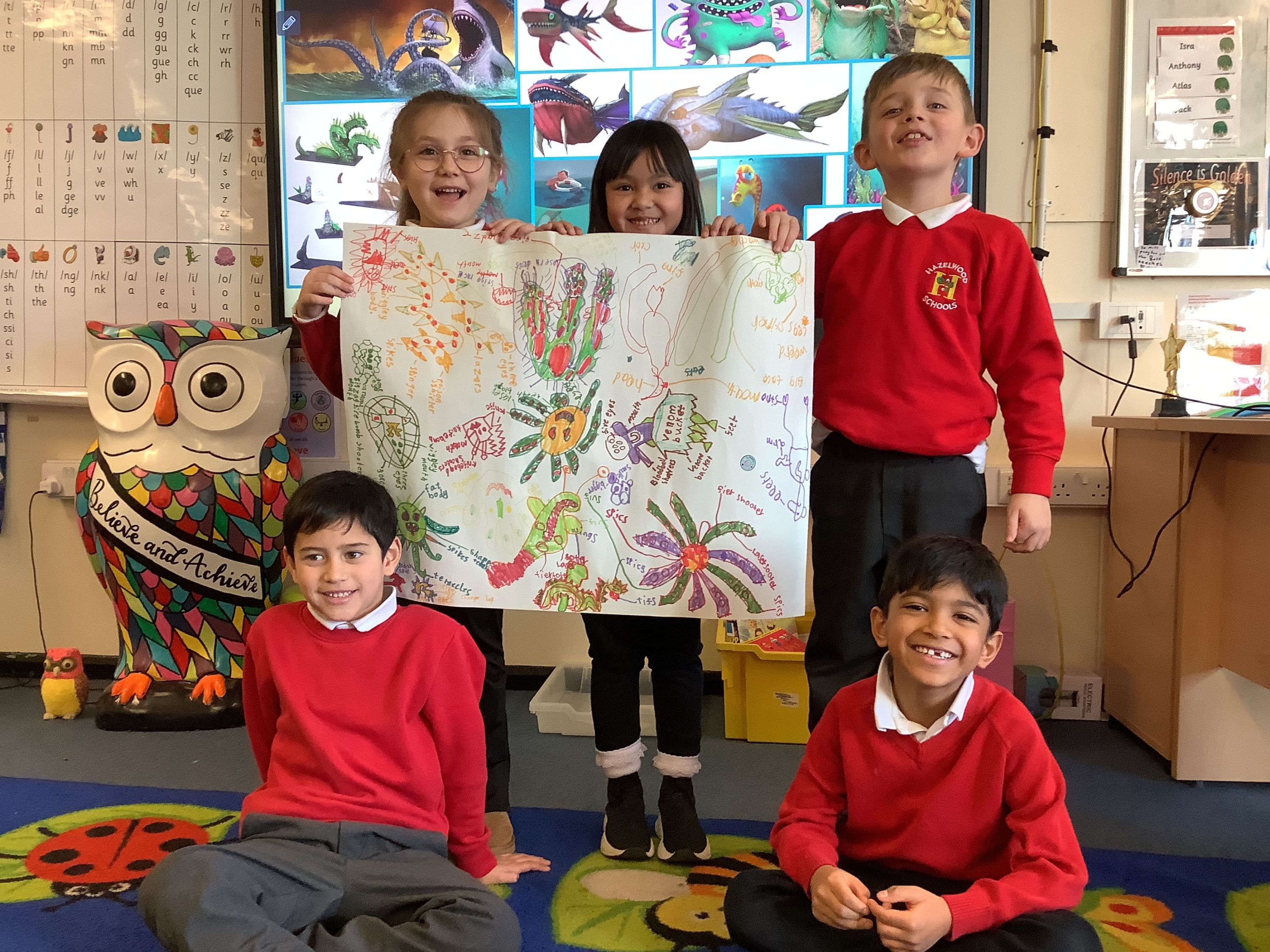 pound. In Computing, they played yes/no games to better understand questioning and the logical processes behind how computer programs work. Geography lessons introduced the new unit Our World, where the children looked at world maps, identified the five continents, and labelled them accurately. In Science, the children studied different animals and their offspring, drawing lifecycles of various animals. They explored how animals grow, comparing lifecycles such as that of a chicken and a frog, discussing the differences in their development.
pound. In Computing, they played yes/no games to better understand questioning and the logical processes behind how computer programs work. Geography lessons introduced the new unit Our World, where the children looked at world maps, identified the five continents, and labelled them accurately. In Science, the children studied different animals and their offspring, drawing lifecycles of various animals. They explored how animals grow, comparing lifecycles such as that of a chicken and a frog, discussing the differences in their development.
Key dates for Spring 1:
Assemblies, in Oak hall:
2 Elm - Monday 20th January
2 Birch - Tuesday 21st January
2 Willow - Wednesday 22nd January
2 Cedar - Thursday 23rd January
Maths parent workshop and class visit: Tuesday 28th January
Expressive painting workshops: Wednesday 12th February
Victorian day
The Year 2 children dressed up and travelled back in time on our Victorian Day! They were absolutely amazing actors, followed the rules of the Victorian school and even wore the Dunce’s hat. They enjoyed participating in all the activities of the day, such as using fabric and wool to make their own peg dolls, playing Victorian games, collating vintage pictures to make a scrapbook and carefully observing objects and creating detailed life drawings.
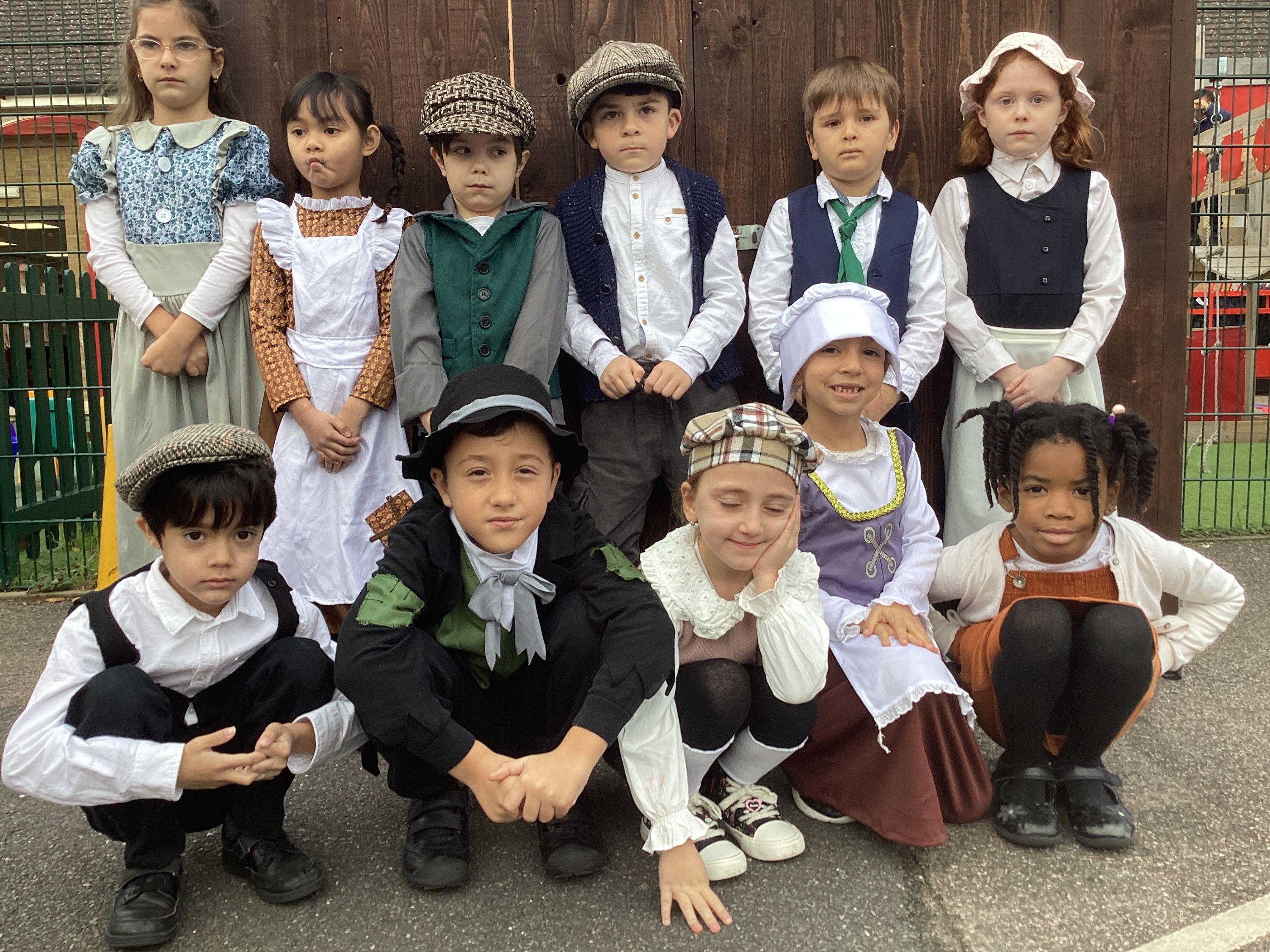

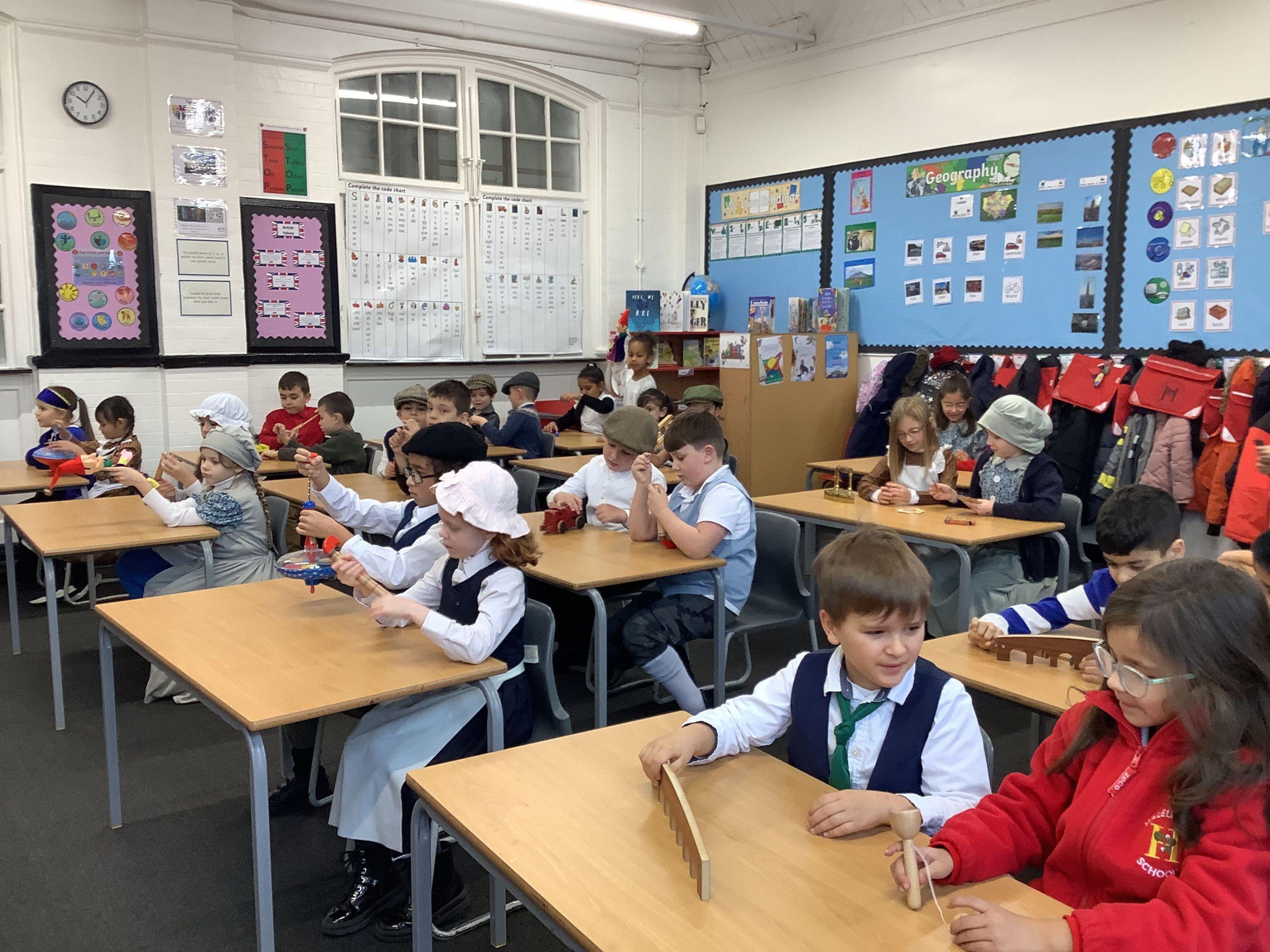

D&T afternoon
During our Design and Technology afternoon, the Year 2 children had a wonderful opportunity to work with parents to create their very own hand puppets. Using fabric scissors and carefully following a pattern, they cut out the fabric pieces needed for their designs. The children then practised threading needles and applying their knowledge of the running stitch to sew the two fabric pieces together. They were very resilient and creative as they overcame challenges and brought their ideas to life. A heartfelt thank you to all the parents who joined us and made the afternoon so special. The children now proudly have handmade puppets, which they will transform into their own "Egg Box Dragon" puppets!
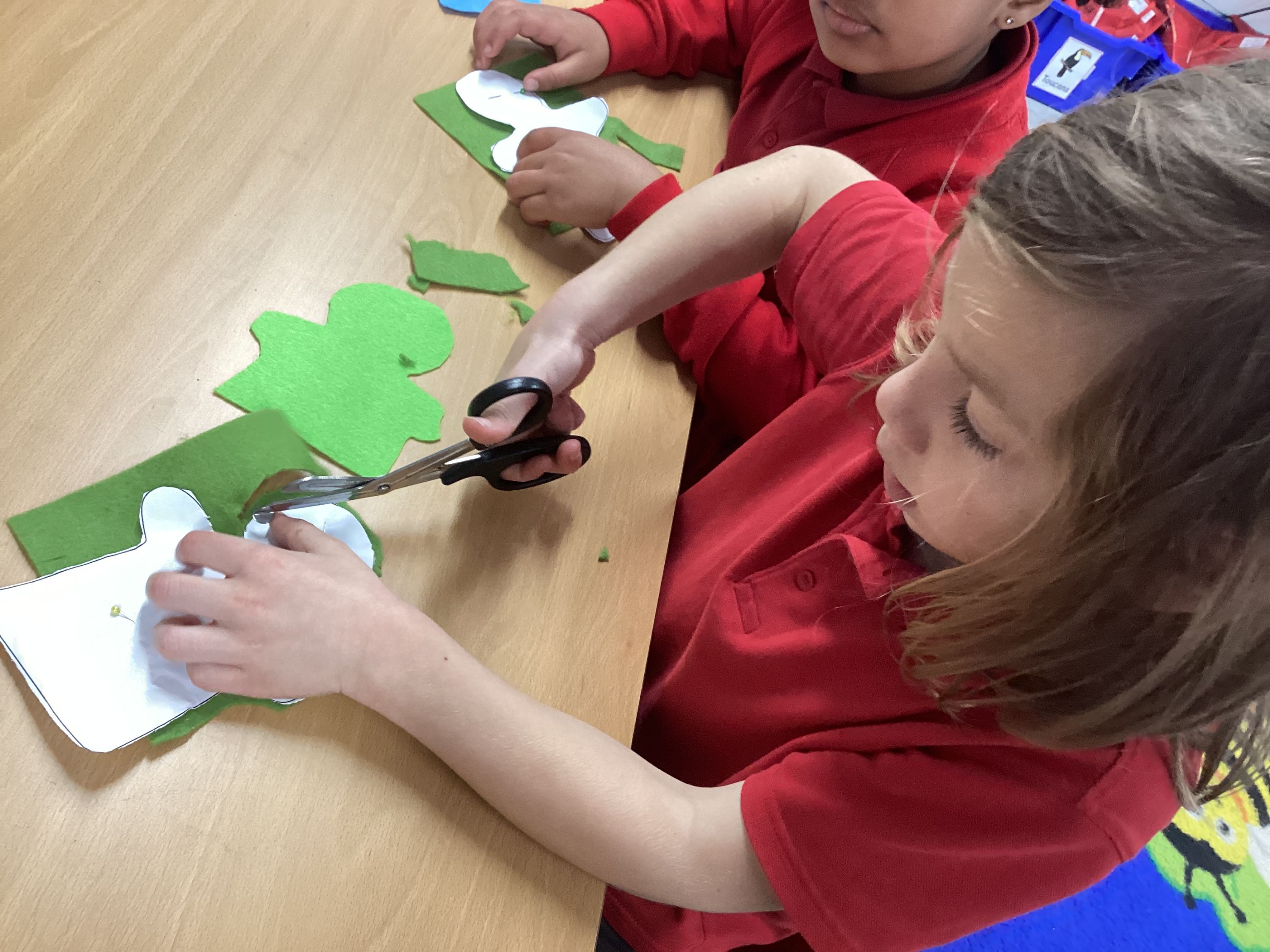

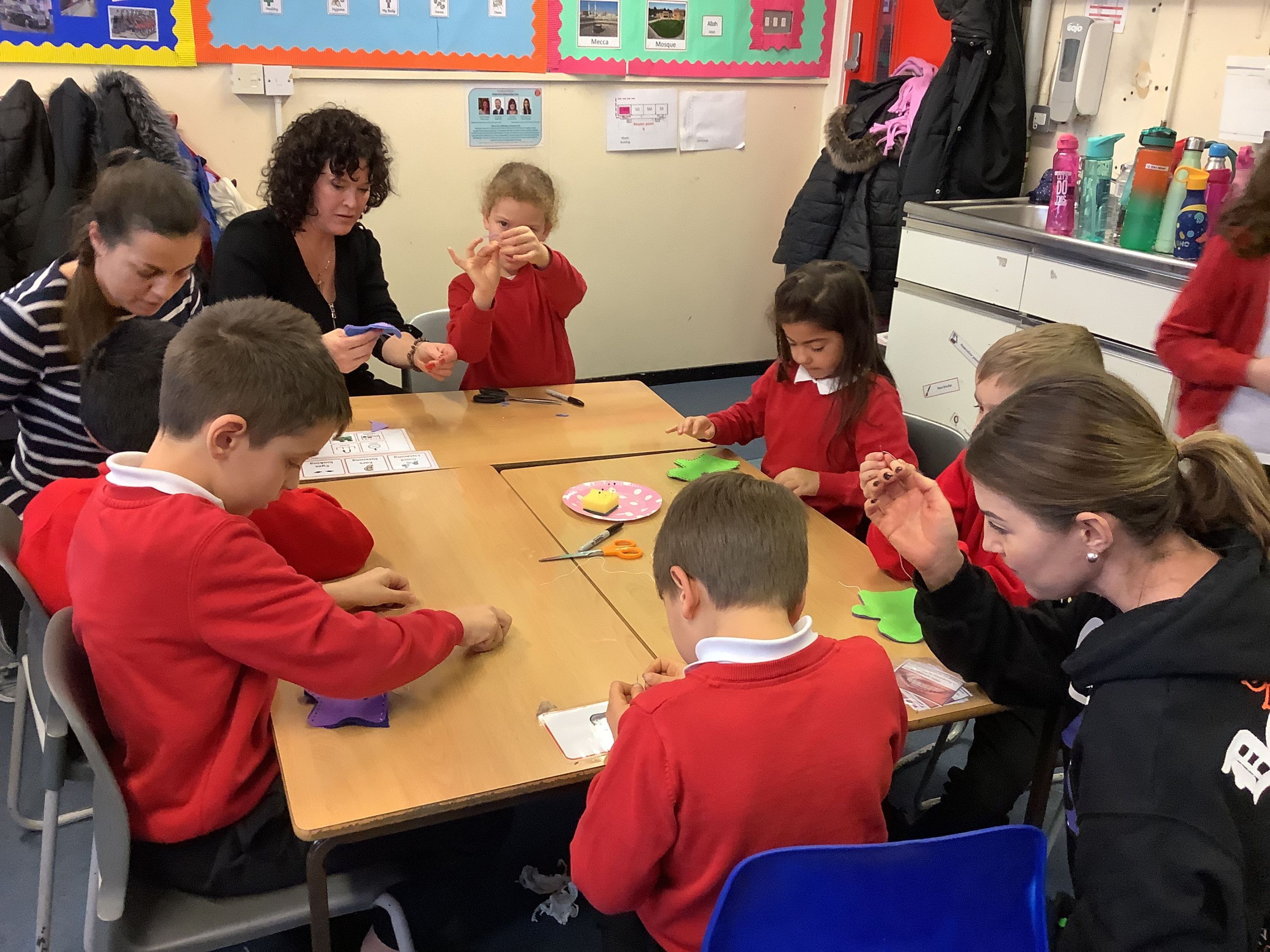
OUR TRIP TO LONDON TRANSPORT MUSEUM
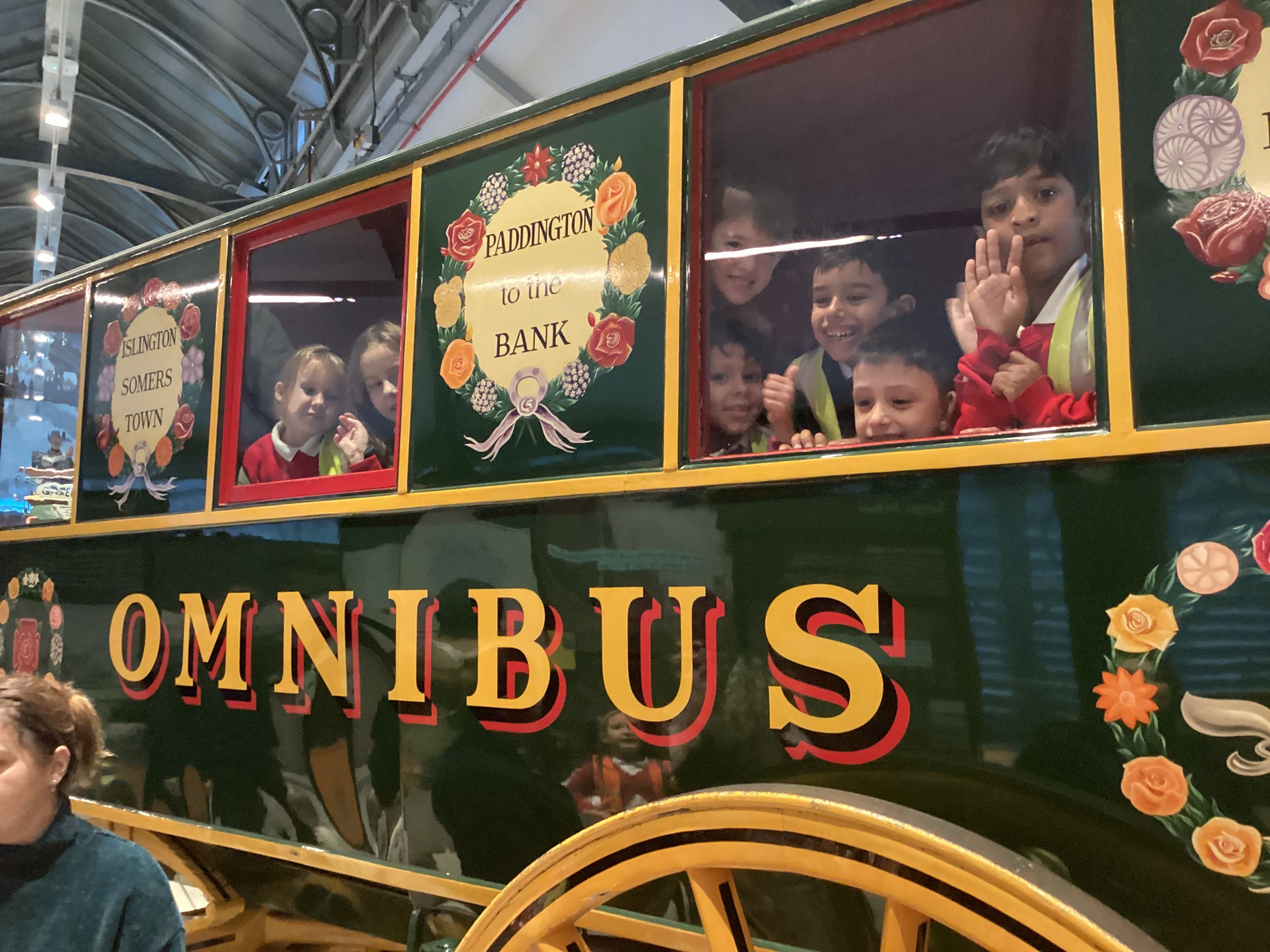 The children visited the London Transport Museum as part of their History and Geography learning, and their personal development. They demonstrated great responsibility while using public transport, successfully navigating the train and utilising the tube map to identify where to get off.
The children visited the London Transport Museum as part of their History and Geography learning, and their personal development. They demonstrated great responsibility while using public transport, successfully navigating the train and utilising the tube map to identify where to get off.
At the museum, they explored the evolution of transportation, beginning with Victorian horse-drawn buses and progressing to modern trains and buses. They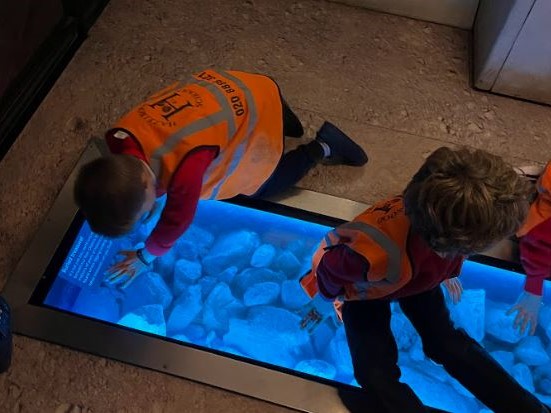 engaged in discussions about the challenges of steam trains, such as their unpleasant smell, and discussed why the Victorians transitioned to electric trains. Additionally, they traced the transformation of buses over time, from horse-drawn carriages to the iconic red double-decker buses that are now a symbol of London.
engaged in discussions about the challenges of steam trains, such as their unpleasant smell, and discussed why the Victorians transitioned to electric trains. Additionally, they traced the transformation of buses over time, from horse-drawn carriages to the iconic red double-decker buses that are now a symbol of London.
Using the maps and visuals displayed throughout the museum, the children also discussed how advancements in transportation influenced population density in London. They explored how improved transport systems encouraged people from other cities to commute to London for work, significantly shaping the city's growth and connectivity.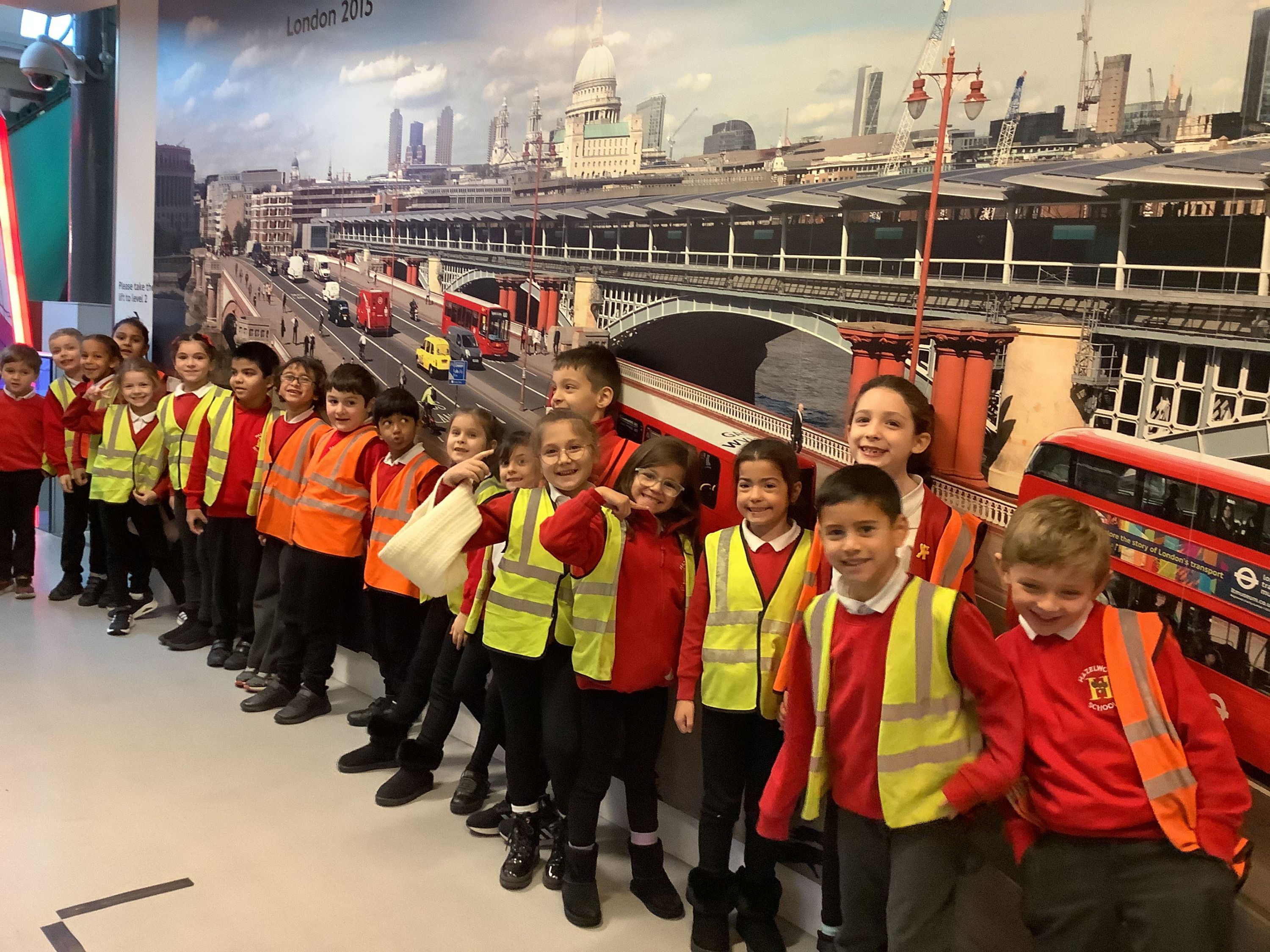
The visit included interactive activities where the children role-played various Transport for London jobs. These roles included train driving, engine maintenance, and designing city maps and posters, giving them a hands-on understanding of the responsibilities and creativity involved in managing urban transport systems.
trip to London transport museum
Year 2 will visit the London Transport Museum, in Covent Garden, as part of the children's personal development and their History learning on Victorian inventions. The museum can accommodate 60 children at a time; hence the four classes will be visiting on different days. 2Elm and 2 Cedar will visit the museum on Tuesday 19th November, 2Birch and 2Willow will visit the museum on Wednesday 20th November. The children will build on their learning on how Victorians developed transportation with their inventions, from the bone shaker bicycle to the steam powered car and then the petrol car. They will also explore how the public transport we use today was developed, such as the first horse-drawn buses and the railway network.
Please click the links below to give permission for your child to attend:
2Elm, 2Cedar: Google Form
2Birch, 2Willow: Google Form
You can find more information in the letters below.
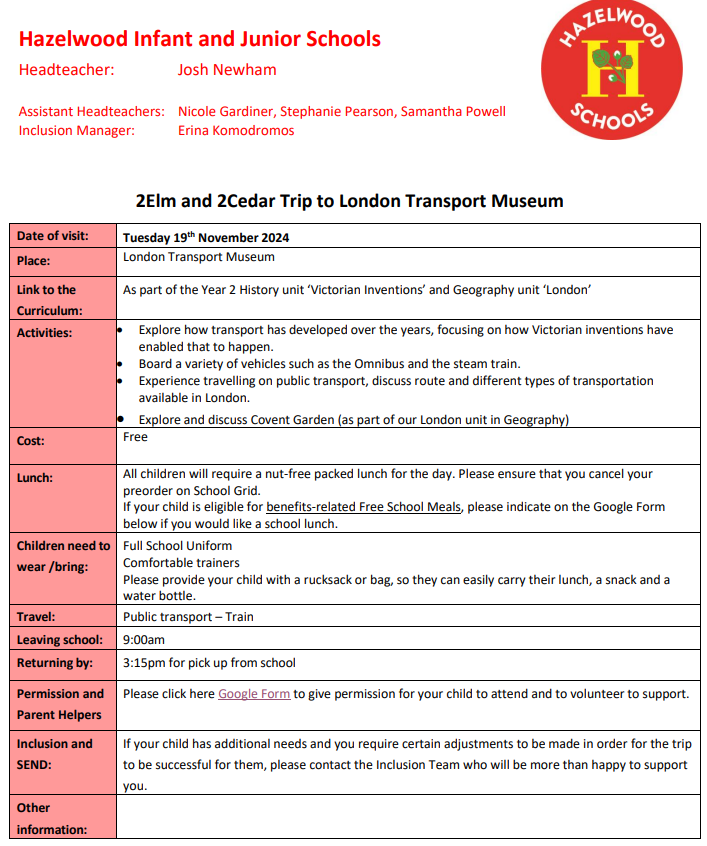

Alexandra Park field trip
The children had a lovely morning at Alexandra Park, as part of their 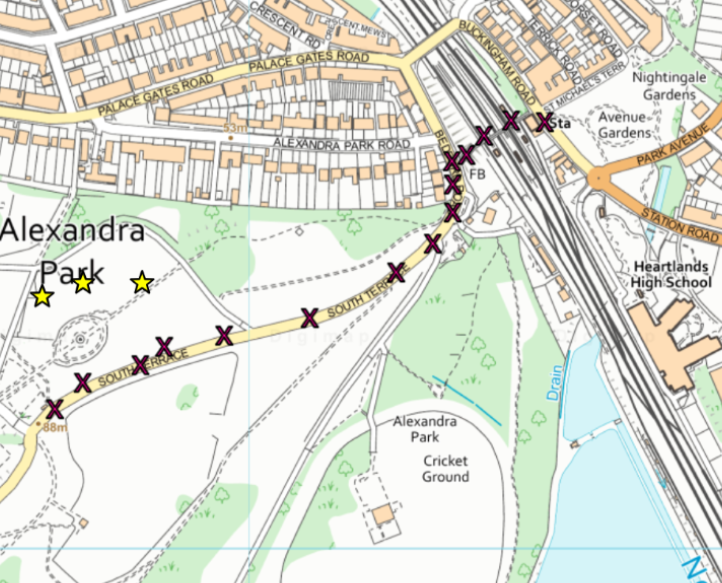 Geography and Art learning, as well as their personal development. Before visiting, we used Digimap to locate Alexandra Park on the map and map out our route. We also explored photos of key physical and human features of the area, as well as the view of London from the park.
Geography and Art learning, as well as their personal development. Before visiting, we used Digimap to locate Alexandra Park on the map and map out our route. We also explored photos of key physical and human features of the area, as well as the view of London from the park.
During our journey on the train, the children demonstrated all of our school values, particularly responsibility and kindness, especially towards other passengers. Whilst walking from the station to the park, the children practised identifying the human and physical features they could see and took photos along the way.
especially towards other passengers. Whilst walking from the station to the park, the children practised identifying the human and physical features they could see and took photos along the way.
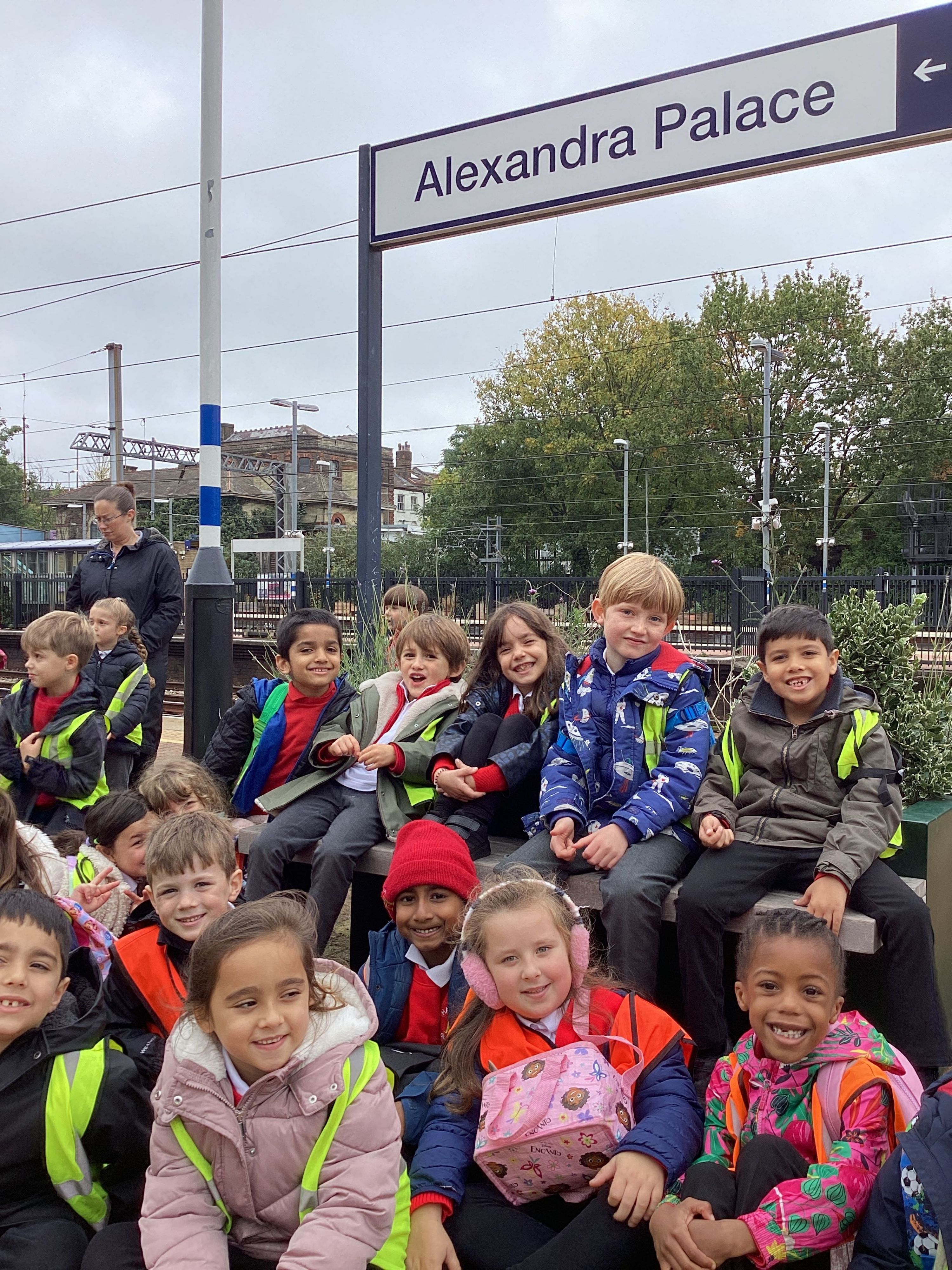 Once we arrived at the park, the children applied their knowledge of London's key physical and human landmarks, observing and identifying them from Alexandra Park, despite the foggy weather! They then drew the London skyline and labelled the landmarks they recognised.
Once we arrived at the park, the children applied their knowledge of London's key physical and human landmarks, observing and identifying them from Alexandra Park, despite the foggy weather! They then drew the London skyline and labelled the landmarks they recognised.
When we returned to school, we uploaded our photos on Digimap and added them to the database!
Planting tulip bulbs
As part of their Science learning and personal development, the children engaged in a hands-on planting activity. With the guidance of our school gardener, they explored the difference between bulbs and seeds, learning that bulbs, unlike seeds, contain stored nutrients that help them survive through winter and bloom into flowers in the spring. They learned that even when the flowers die back, the bulbs remain in the soil, ready to grow again in the next season. Guided by an adult, the children prepared the soil in the Year 2 playground, carefully digging out the earth and planting tulip bulbs. They gently covered the bulbs with soil, setting the stage for a beautiful transformation in the coming months. They will now observe and nurture the tulip bulbs, watching them slowly grow and bloom over time. You can visit your child's Google Classroom to see more photos of this activity.
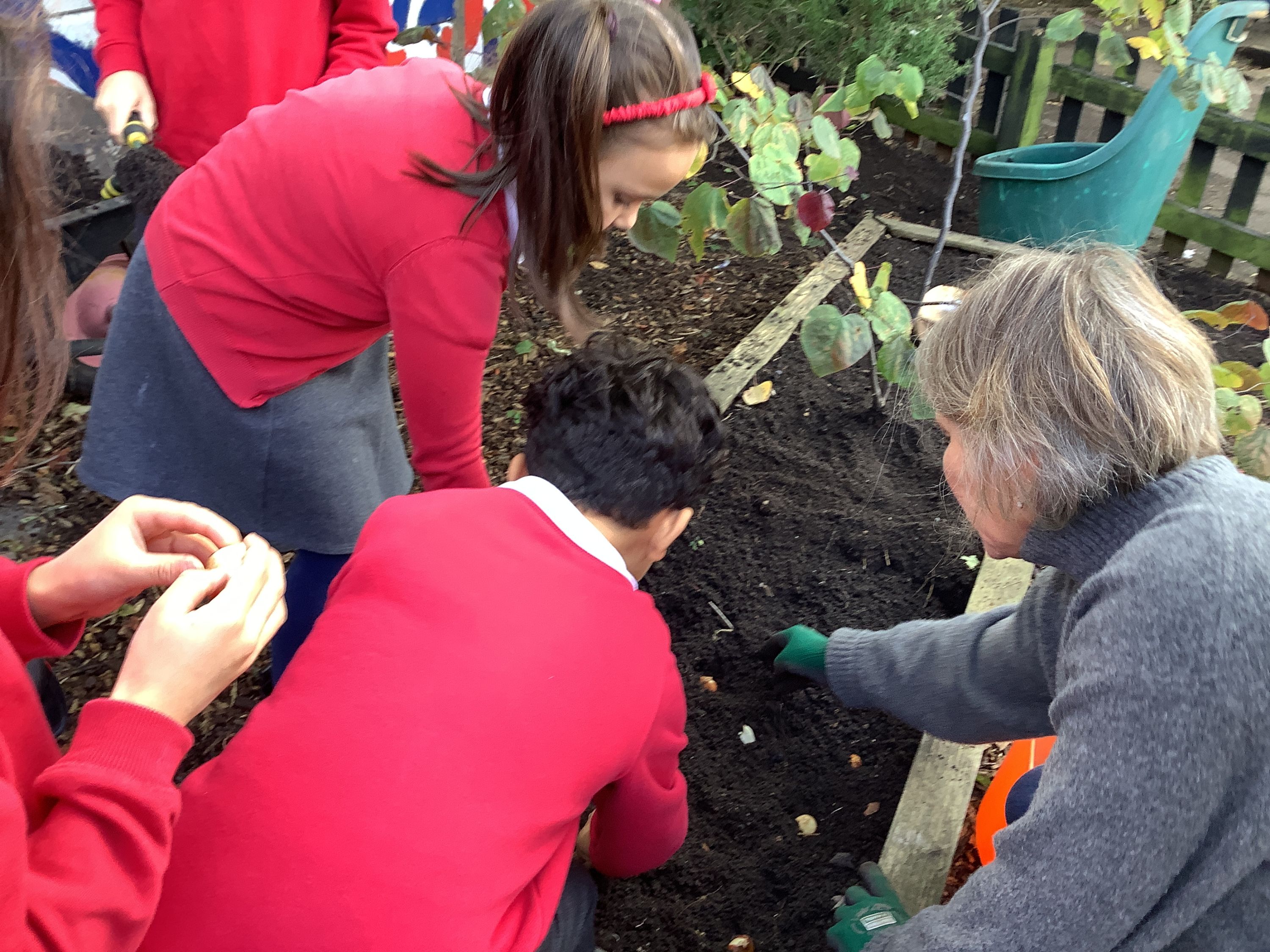

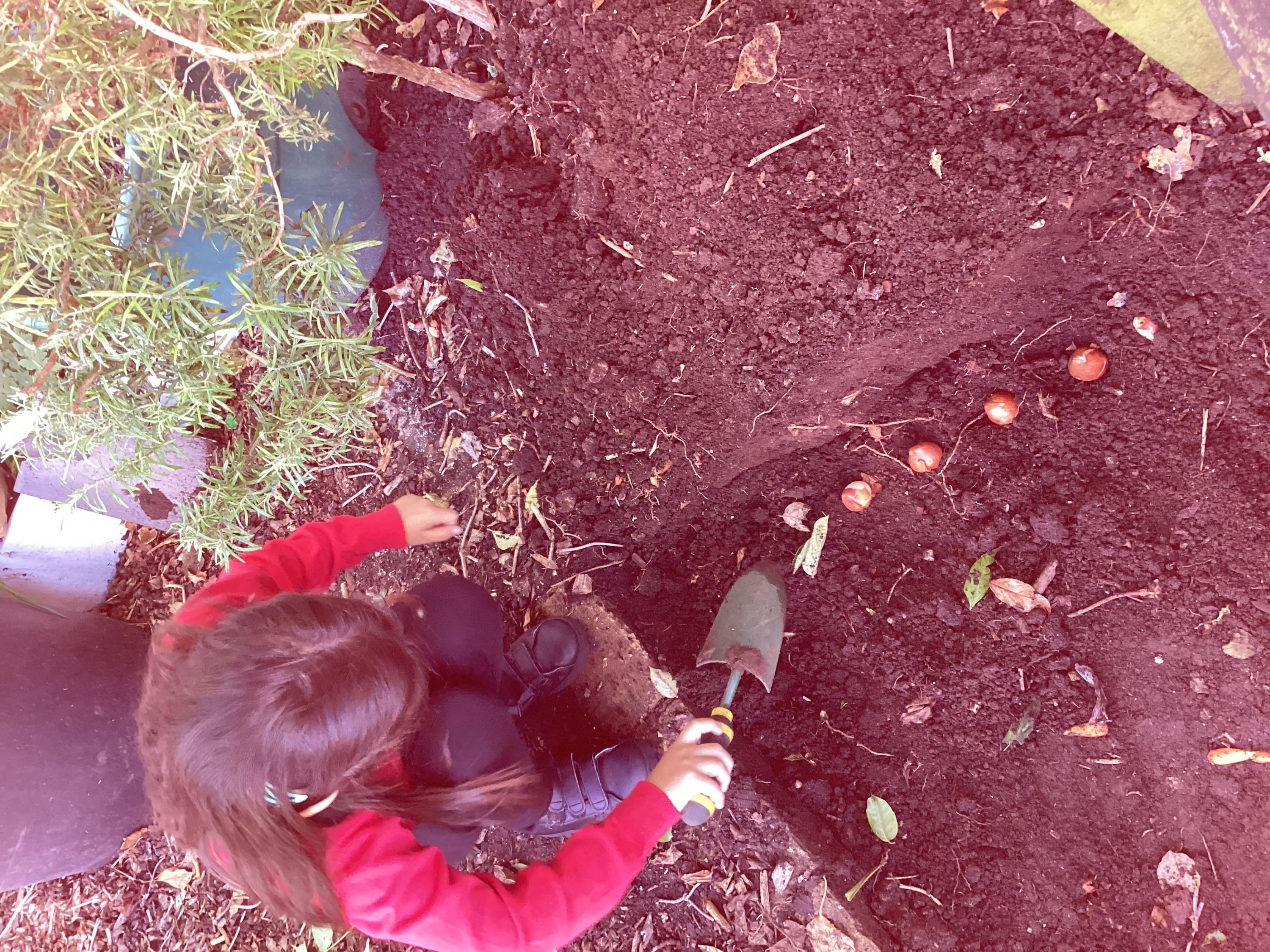
Alexandra park field trip
The Year 2 children will visit Alexandra Park on Tuesday 15th October, as part of our Geography unit on London. The children will apply their learning on key physical and human features and landmarks of London as they view and identify them from Alexandra Park. They will then have a go at drawing the London skyline and labelling these landmarks. Weather permitting, the children will have a picnic at the park, before returning to school.
You can find more information in the letter below. If you haven't done so already, please fill in this Google form, to give permission for your child to attend.
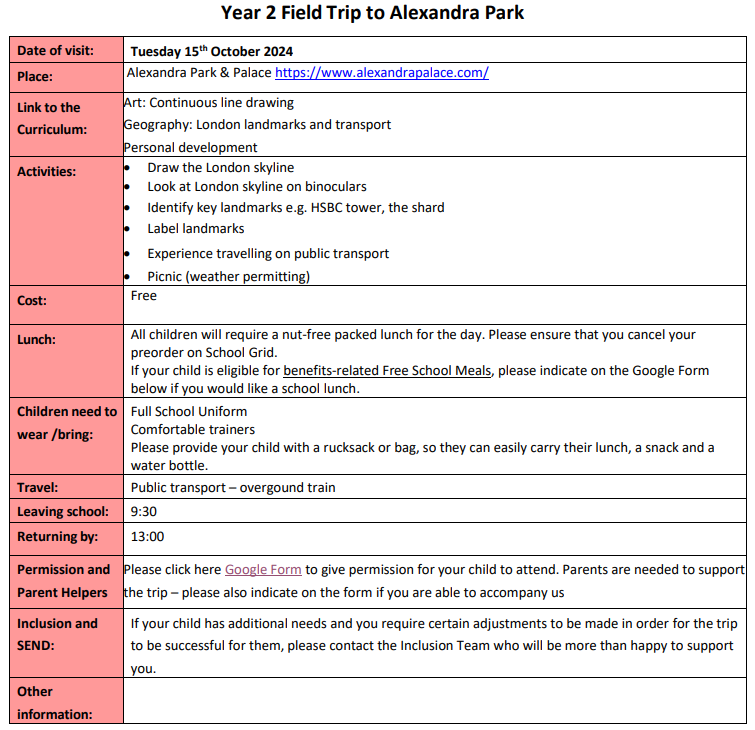
visiting Palmers Green Mosque
As part of our Religious Education (R.E.) learning on Islam and to support the children’s personal development, we visited our local mosque. 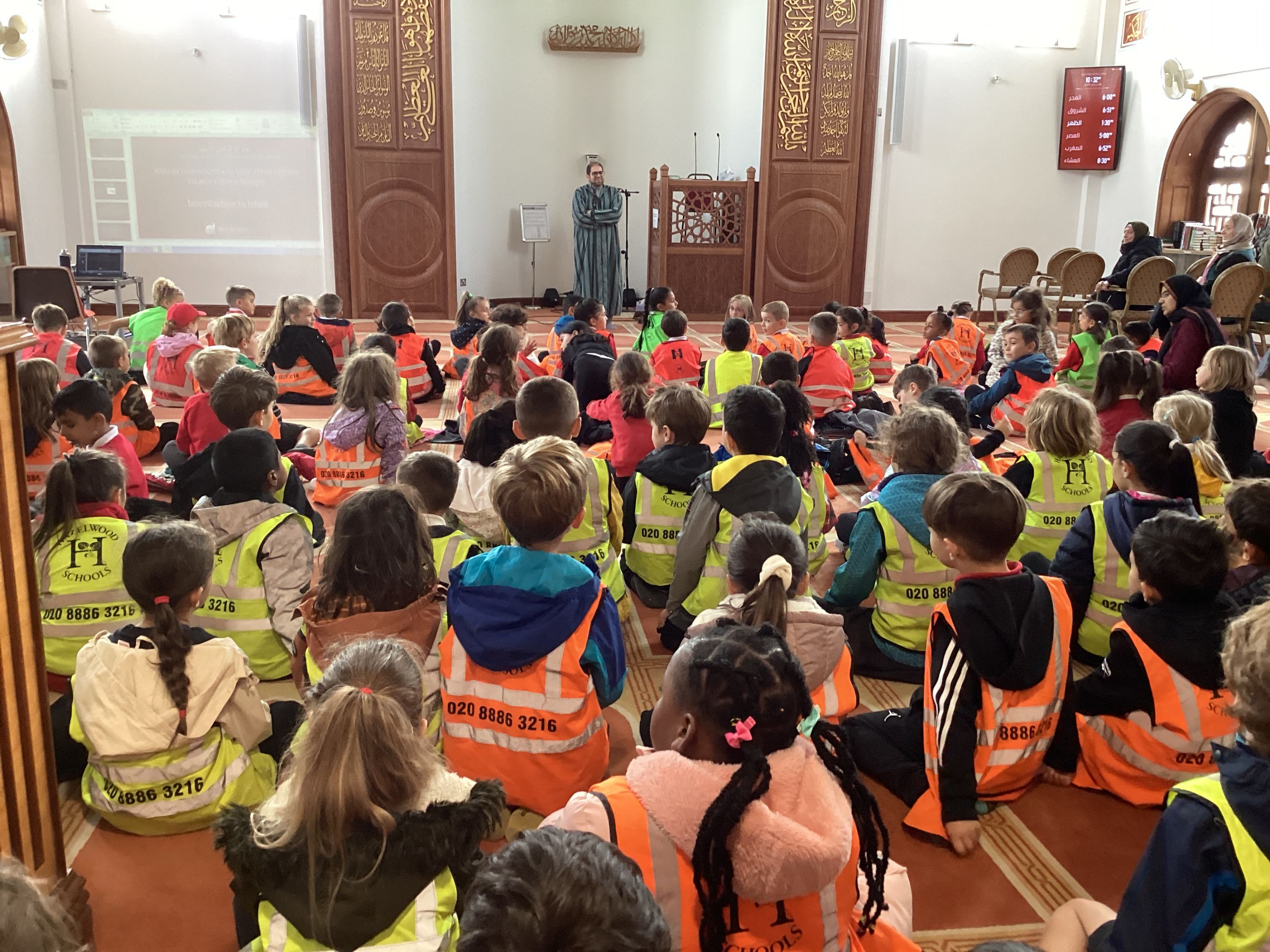
One of the highlights was learning how to greet others in Arabic. The children enthusiastically practised saying "Salam alaikum" (peace be upon you) and responding with "Wa alaikum salam" (and peace be upon you too).
Inside the mosque, we were joined by the Imam, who shared insights into the Arabic language, explaining some of the beautiful writing displayed around the mosque. He also introduced the children to key Islamic beliefs, such as the belief in one God, Allah, and the significance of prophets like Adam, Noah, and Muhammad in Islam. The children revisited their learning about the Qur'an, the holy book of Islam, and the stories it contains from these prophets.
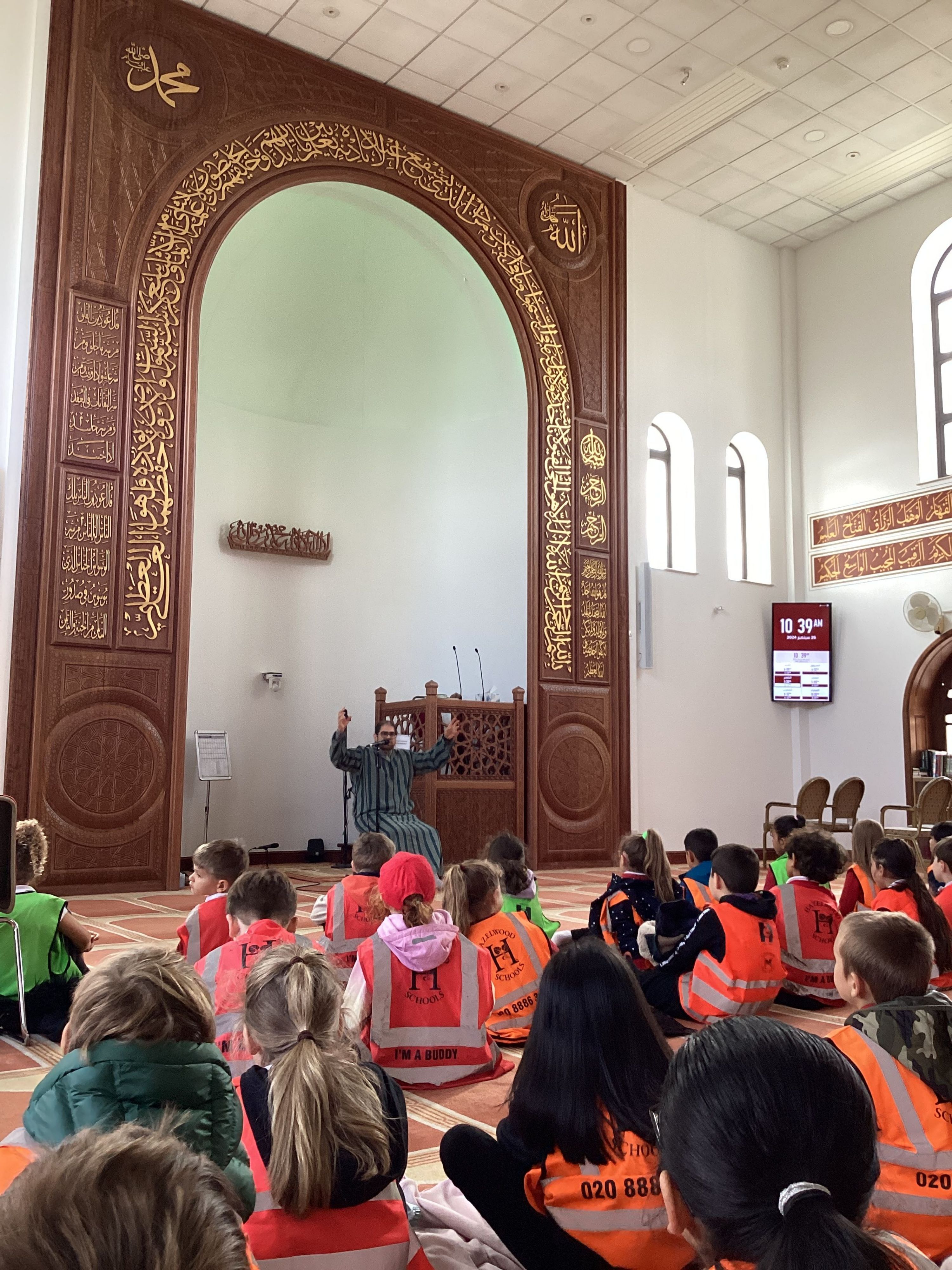 The Imam explained his role in leading the congregation during prayer and described how Muslims pray five times a day, either individually or in a community setting at the mosque. We learned that Muslims pray facing a specific direction—towards the city of Mecca, where the Kaaba, the most sacred site in Islam, is located.
The Imam explained his role in leading the congregation during prayer and described how Muslims pray five times a day, either individually or in a community setting at the mosque. We learned that Muslims pray facing a specific direction—towards the city of Mecca, where the Kaaba, the most sacred site in Islam, is located.
The children were especially interested in the unique design of the prayer hall, which is circular to allow the Imam’s voice to reach everyone during prayer. They listened to the call to prayer, a gentle reminder that it was time for Muslims to pray, and were able to observe the different prayer positions Muslims use during worship.
We also explored other parts of the mosque, including the wudu area, where Muslims perform a ritual washing to cleanse themselves before prayer. The concept of physical and spiritual cleanliness was discussed, giving the children further insight into the importance of preparation before prayer in Islam.
This visit was a wonderful opportunity for the children to deepen their knowledge of Islamic traditions and practices, while also fostering their personal development through respect and appreciation for different cultures and faiths.
Educational Visit - palmers green mosque
As part of our Religious Education unit on Islam, the Year 2 children will visit Palmers Green Mosque on Thursday 26th September, to support their personal development. The children will participate in a tour around the Mosque and learn more about what happens at the Mosque. They will also learn about how and why Muslims pray and develop their understanding of Muslim traditions.
Please see the letter below for more information. Please click here Google Form to give permission for your child to attend. Parents are needed to support the trip – please also indicate on the form if you are able to accompany us.
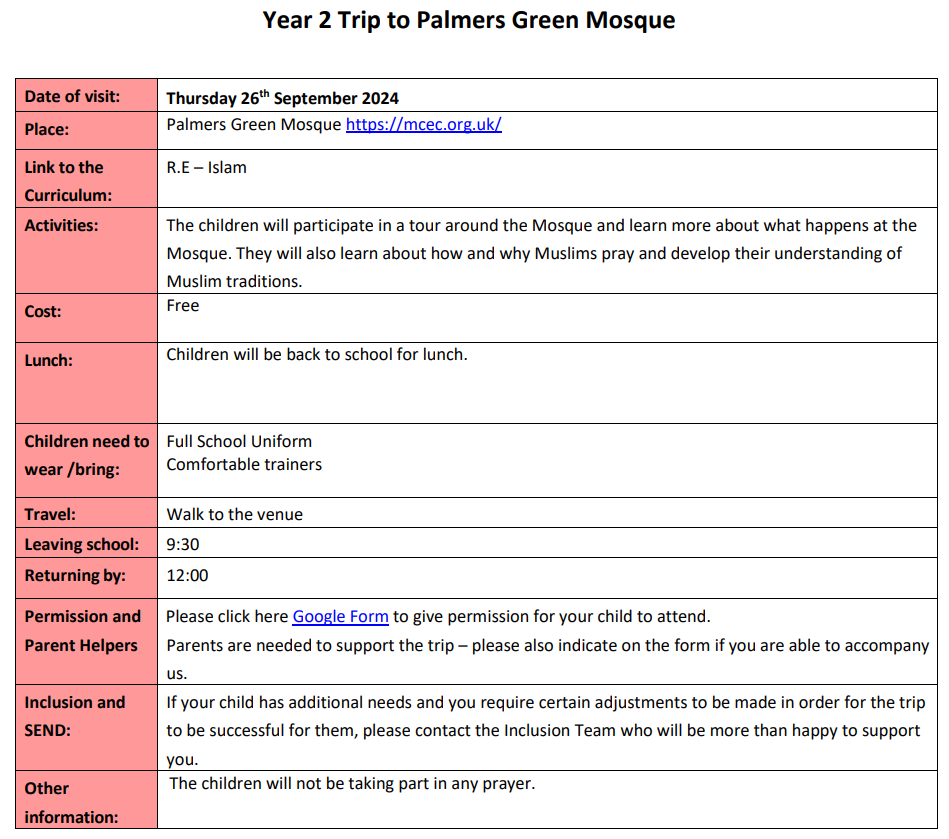
Our first week back!
The Year 2 children have had a wonderful return to schoo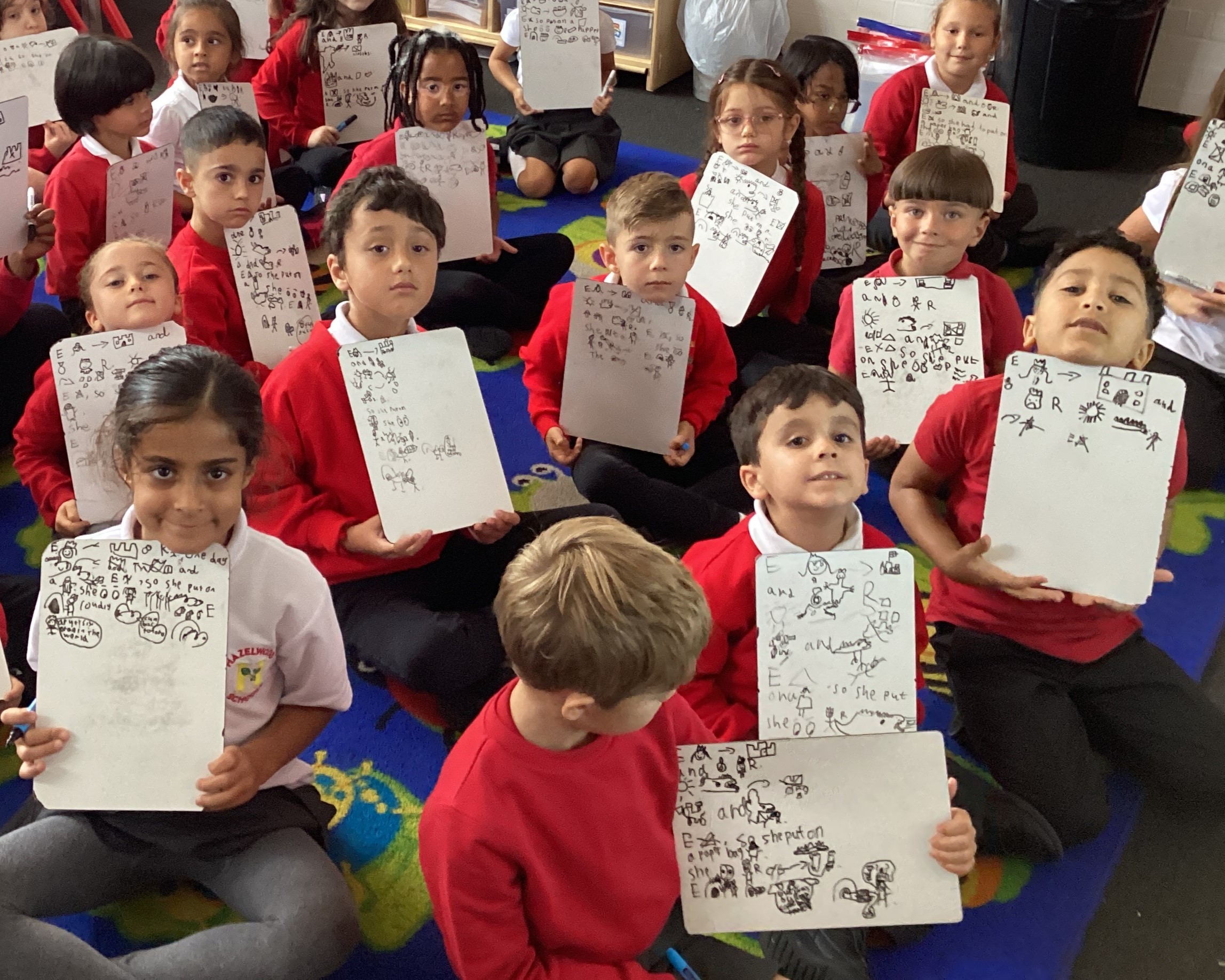 l! In English, they were introduced to “The Paperbag Princess” by Robert Munsch, a story that captured their imagination. They fully engaged with the text by acting out key scenes, creating story mountains and story maps to break down the narrative structure. These visual tools helped them rehearse the story orally, building their confidence with storytelling. Next, they will take their creativity even further by innovating the story and writing their own unique versions.
l! In English, they were introduced to “The Paperbag Princess” by Robert Munsch, a story that captured their imagination. They fully engaged with the text by acting out key scenes, creating story mountains and story maps to break down the narrative structure. These visual tools helped them rehearse the story orally, building their confidence with storytelling. Next, they will take their creativity even further by innovating the story and writing their own unique versions.
I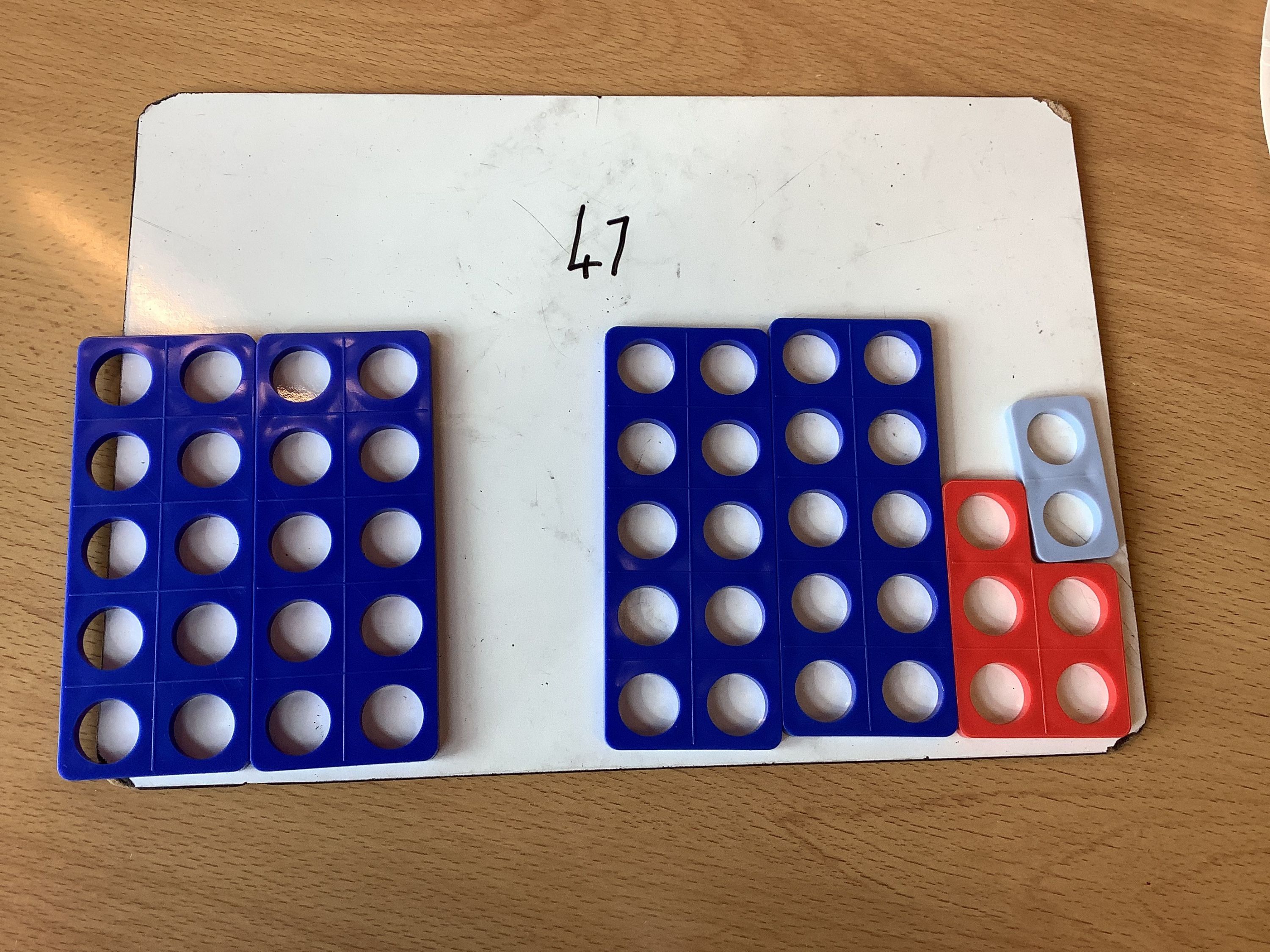 n Maths, the children focused on identifying the place value of numbers up to 100, using their knowledge to partition numbers in various ways. They worked with manipulatives, like dienes and number shapes, to help them visualize and explore different number combinations.
n Maths, the children focused on identifying the place value of numbers up to 100, using their knowledge to partition numbers in various ways. They worked with manipulatives, like dienes and number shapes, to help them visualize and explore different number combinations.
The children were also introduced to this half term’s Science unit, "Living Things and Their Habitats." They explored a wide variety of animals, discussing how each adapts to its environment. In Art, the children explored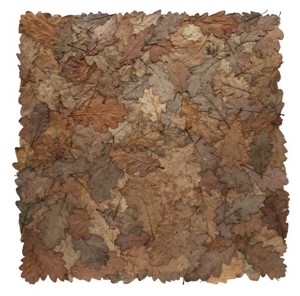 how artists are inspired by their environment, focusing on the work of Alice Fox. They learned how she transforms materials found in her allotment—such as nettles and broken tiles—into beautiful art. The children reflected on their own environment, discussing what inspires them. They recorded their ideas through both drawings and writing in their sketchbooks, making meaningful connections between art and nature.
how artists are inspired by their environment, focusing on the work of Alice Fox. They learned how she transforms materials found in her allotment—such as nettles and broken tiles—into beautiful art. The children reflected on their own environment, discussing what inspires them. They recorded their ideas through both drawings and writing in their sketchbooks, making meaningful connections between art and nature.





























 Geography and Art learning, as well as their personal development. Before visiting, we used Digimap to locate Alexandra Park on the map and map out our route. We also explored photos of key physical and human features of the area, as well as the view of London from the park.
Geography and Art learning, as well as their personal development. Before visiting, we used Digimap to locate Alexandra Park on the map and map out our route. We also explored photos of key physical and human features of the area, as well as the view of London from the park. 






 how artists are inspired by their environment, focusing on the work of Alice Fox. They learned how she transforms materials found in her allotment—such as nettles and broken tiles—into beautiful art. The children reflected on their own environment, discussing what inspires them. They recorded their ideas through both drawings and writing in their sketchbooks, making meaningful connections between art and nature.
how artists are inspired by their environment, focusing on the work of Alice Fox. They learned how she transforms materials found in her allotment—such as nettles and broken tiles—into beautiful art. The children reflected on their own environment, discussing what inspires them. They recorded their ideas through both drawings and writing in their sketchbooks, making meaningful connections between art and nature.












